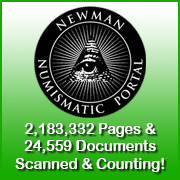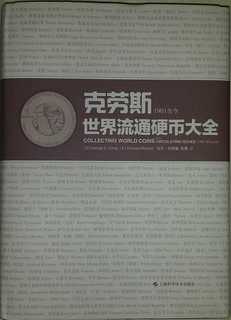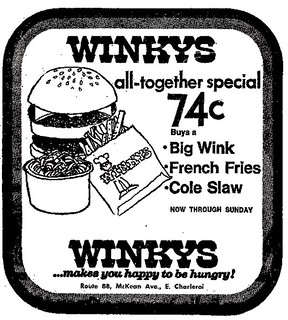
About UsThe Numismatic Bibliomania Society is a non-profit association devoted to the study and enjoyment of numismatic literature. For more information please see our web site at coinbooks.org SubscriptionsThose wishing to become new E-Sylum subscribers (or wishing to Unsubscribe) can go to the following web page link MembershipThere is a membership application available on the web site Membership Application To join, print the application and return it with your check to the address printed on the application. Print/Digital membership is $40 to addresses in the U.S., and $60 elsewhere. A digital-only membership is available for $25. For those without web access, write to: Terry White, Treasurer AsylumFor Asylum mailing address changes and other membership questions, contact Terry at this email address: terrywhite5475@yahoo.com SubmissionsTo submit items for publication in The E-Sylum, write to the Editor at this address: whomren@gmail.com BUY THE BOOK BEFORE THE COINSale Calendar
|
- WAYNE'S WORDS: THE E-SYLUM AUGUST 15, 2018
- NBS EVENTS AT THE 2018 ANA WORLD'S FAIR OF MONEY
- NEWMAN-MALLIS COIN SCALES BOOK OFFERED
- NEW BOOK: GUIDE BOOK OF CIVIL WAR TOKENS, 3RD ED.
- NEW BOOK: CONFEDERATE NUMISMATICA SUPPLEMENT ONE
- NEW BOOK: COLLECTING WORLD COINS CHINESE EDITION
- WALTER BREEN's COMPLETE ENCYCLOPEDIA
- ANA PRESENTS 2018 LITERARY AWARDS
- MEET WHITMAN AUTHORS IN PHILADELPHIA
- MINT TO DISPLAY THREE 1933 DOUBLE EAGLES
- 19TH CENTURY NATIONAL NUMISMATIC COLLECTION RECORDS
- DIE STRIATIONS AND DIE TRAILS
- DIE ADJUSTMENT STRIKES
- NOTES FROM E-SYLUM READERS: AUGUST 12, 2018
- THE THIRTEENTH LABOR OF HERCULES
- VOCABULARY TERMS: METAL FLOW, FLOW MARKS
- WILLIAM KLAHR MILLER (1842-1923)
- JOHN E. HERZOG: FRIEND OF FINANCIAL HISTORY
- TED BINION AND THE BINION SILVER DOLLAR HOARD
- QUERY: ST. LOUIS POST OFFICE TOKENS
- QUERY: PEARL HARBOR VETS CONGRESSIONAL MEDAL DIE
- DAVE BOWERS ON COLLECTING CIVIL WAR MONEY
- CNG AUCTION 109 CLOSES SEPTEMBER 18, 2018
- STACK'S BOWERS AUGUST 2018 AUCTION SELECTIONS
- FRANK VITTOR'S PITTSBURGH VENUS
- THE COINAGE OF MUGHAL EMPRESS NUR JAHAN
- THE ROYAL MINT'S COLLECTIVE SHIELD REVERSES
- WORCESTERSHIRE MEDAL SERVICE FOUNDER
- THE PETERLOO MASSACRE MEDAL
- ARTIST GRAHAM SHORT GOT BANK OF ENGLAND OK
- ART UNITS: COINS MADE OF GLASS
- IN OTHER NEWS: AUGUST 12, 2018
- PERTH MINT WORKER STOLE $40K IN GOLD
Click here to access the complete archive
To comment or submit articles, reply to whomren@gmail.com
Content presented in The E-Sylum is not necessarily researched or independently fact-checked, and views expressed do not necessarily represent those of the Numismatic Bibliomania Society.
WAYNE'S WORDS: THE E-SYLUM AUGUST 15, 2018
 This week we open with a final review of
events at this week's ANA gathering in Philadelphia, PA, a classic book on coin scales and counterfeit detecting scales, three new books, and background on Breen's
Encyclopedia.
This week we open with a final review of
events at this week's ANA gathering in Philadelphia, PA, a classic book on coin scales and counterfeit detecting scales, three new books, and background on Breen's
Encyclopedia.
Other topics this week include the ANA Literary Awards, Whitman book authors, 1933 Double Eagles, dies striations, die trails and die adjustment strikes, William K. Miller, John Herzog, Ted Binion, Empress Nur Jahan, and the Peterloo Massacre medal.
To learn more about Civil War tokens, Confederate numismatica, the 1869 Mint Cabinet inventory, flow marks, St. Louis Post Office tokens, the Mary Portrait Testoon, the Daniel Morgan at Cowpens splashers, witness lines, error coins, glass coins and the Royal Mint's shield reverses, read on. Have a great week, everyone!
Wayne Homren
Editor, The E-Sylum
NBS EVENTS AT THE 2018 ANA WORLD'S FAIR OF MONEY
LAST CALL! Here's our final reminder of Numismatic Bibliomania Society events at this week's American Numismatic Association convention. -Editor
Please visit us at Table 1414 on the bourse near the Kolbe & Fanning and Charles Davis Numismatic Literature tables.
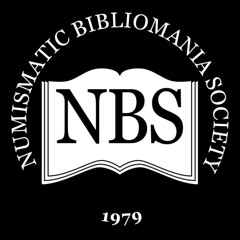 THURSDAY, AUGUST 16
THURSDAY, AUGUST 16
11:30 to 1:00 NBS Board Meeting (open to members), Room 120C
1:00 to 2:30 NBS Symposium, Room 120C Speaker: Roger Burdette on research at the National Archives.
FRIDAY, AUGUST 17
11:30 to 1:30 NBS General Meeting and Fundraising Auction, Room 117
Speaker: David Fanning on current state of numismatic literature market. The Asylum Award winners will be announced.
All events take place in the Philadelphia Convention Center.
Send your photos (JPGs with captions) of NBS members and events from the ANA to nbsasylum@gmail.com by September 1 to be included in
The Asylum Fall issue.
Dan Hamelberg adds:
I am going to bring my M.A. Brown sale and plates to the ANA for NBS display. This was an SH & H Chapman sale on April 16-17, 1897 and was originally intended to be a large format plated catalog with four photographic plates of large cents. At the time, the Treasury Department was somewhat concerned about any U.S. coins or currencies being reproduced by a photographic process. Treasury agents gained information about the pending Chapman M.A. Brown Sale with photographic plates (could it be that some competitor was upset?) and they seized the original glass negatives and destroyed them before the catalogue could be completed.
However, two sets of proof prints were produced before the glass negatives were taken. One of the sets was cut horizontally through the center so it could fit into the smaller size catalogue. The other set survived intact in its original full-size format. I can bring both sets of plates along with the firm's bid book containing prices and names. I also have a second copy with prices and names along with interesting notations.
The Chapmans produced 46 total regular plated catalogs. The M.A. Brown sale plates are unique. Without U. S. Treasury glass negatives confiscation, the number of Chapman plated sales would have increased by one. Perhaps more plated catalogs might have been produced as well without the expectation of possible seizures of photographic plate negatives. In any event, the Chapman plated catalogs are considered a high point of late 19th and early 20th century plated coin auction catalogs produced in the United States, and a high point of any numismatic literature collection.
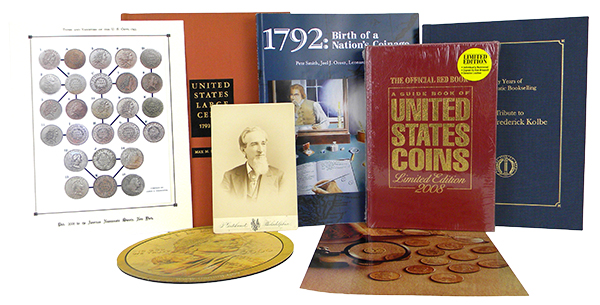
Each year at the ANA World's Fair of Money, the Numismatic Bibliomania Society conducts a benefit auction to raise funds for the organization. All items sold are donated to the NBS by members and 100% of the proceeds go to the NBS treasury.
This year, we are trying to increase participation in the auction by distributing a catalogue of the sale to all NBS members so that members unable to attend in person can participate. You can download a PDF of the catalogue here .
Absentee bids should be sent to David Fanning at df@numislit.com by the end of Thursday, August 16. The sale will take place on Friday, August 17 as part of the NBS General Meeting, to be held in Room 117 of the Philadelphia Convention Center from 11:30 a.m. to 1:30 p.m. Please read the terms of sale before bidding.
Thank you for your support of the NBS!
To download the catalogue, see:
https://gallery.mailchimp.com/5c68a72f4948c463818f613c2/files/9d01bd03-e538-433c-a4a0-9032ab8942a9/NBS_Auction_2018.pdf
I'll arrive at the show mid-day Wednesday and stay through Saturday morning. I'm looking forward to the NBS meetings and all the other educational and social events of the show. I hope to see many of our E-Sylum readers there.
And while you're at the show please visit our many current and past supporters who will have tables at the show. Here they are in numerical order (apologies if I've missed anyone!).
E-Sylum Supporters With Tables At the Show
155 Central States Numismatic Society
236 Whitman Publishing
246 Pennsylvania Association of Numismatists (PAN)
313 Archives International Auctions, LLC
425 Northeast Numismatics
429 Douglas Winter Numismatics
440 Steve Hayden Tokens & Medals
510 Mid-American Rare Coin Galleries
523 Legend Numismatics
556 Cunningham Exonumia
611 Stack's Bowers Galleries
632 Harry Laibstain Rare Coins
711 Heritage Numismatic Auctions, Inc.
728 Julian M. Leidman / Bonanza Coins
733 David Lawrence Rare Coins
740 John Kraljevich Americana
825 Kagin's Auctions
840 Gerry Fortin Rare Coins
923 CDN Publishing, LLC
947 Wayne Herndon Rare Coins Inc
1043 John Dannreuther Rare Coins
1125 Littleton Coin Company
1132 Fred Weinberg & Co.
1215 Kolbe & Fanning
1314 Charles Davis
1333 Daniel Frank Sedwick LLC
1337 Dix Noonan Web
1414 Numismatic Biblomania Society (don't forget our club table!)
1428 Shanna Schmidt Numismatics Inc.
1451 Classical Numismatic Group
THANK YOU! Please do stop by and let them know you appreciate their support for The E-Sylum, and encourage others to consider doing the same. It's a great way to get in front of thousands of the most active and engaged collectors in the U.S. and the world, and to support a great platform for numismatic information exchange. Don't forget to mention we also have an ANA Edition, which further reaches thousands of members of the American Numismatic Association. -Editor
NEWMAN-MALLIS COIN SCALES BOOK OFFERED
Numismatic Booksellers Kolbe & Fanning are offering an important but scarce book on U.S. Coin scales and counterfeit coin detectors. Here's the announcement. -Editor
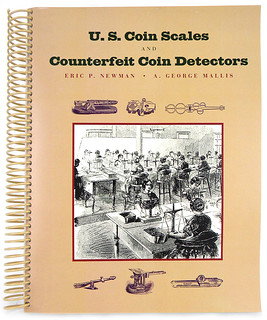 In 1999, Eric P. Newman and A. George
Mallis published a nearly 400-page encyclopedia on U.S. Coin Scales and Mechanical Counterfeit Coin Detectors. For years, this work has been difficult to find, bringing
upwards of $200 when offered at auction.
In 1999, Eric P. Newman and A. George
Mallis published a nearly 400-page encyclopedia on U.S. Coin Scales and Mechanical Counterfeit Coin Detectors. For years, this work has been difficult to find, bringing
upwards of $200 when offered at auction.
A small quantity of copies of this volume "the most comprehensive work yet published on the subject" has been discovered and copies are available for a limited time for $50 plus $5 shipping.*
Kolbe & Fanning will have this title available at Table 1215 at the ANA World's Fair of Money in Philadelphia, August 14—18. It can also be ordered now from our website at numislit.com. Only one copy may be ordered per customer at this special price.
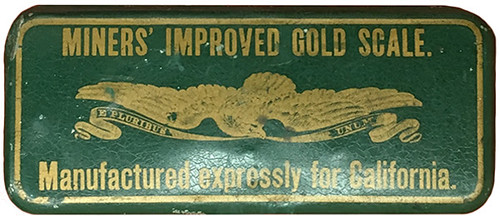
The collection of coin scales, weights, coin banks, counters and devices, and mechanical counterfeit coin detectors owned by the Eric P. Newman Numismatic Education Society will be sold in Heritage's November 7—9, 2018 sale in Dallas. The discovery of these copies of Newman & Mallis comes at the perfect time to learn about these ingenious mechanical devices, so important to merchants and bankers of the 18th and 19th centuries in sorting the good from the bad.
Order your copy today!
* $5 shipping offer is domestic only via USPS Media Mail. Priority mail and foreign shipping available at actual cost.
I was lucky to purchase a copy of this great book for my library early on and have had it ever since. With the upcoming sale of Eric's landmark collection, I think these will sell out fast. If you have any interest, act quickly. -Editor
To order online, see:
https://www.numislit.com/pages/books/5124/eric-p-newman-a-george-mallis/u-s-coin-scales-and-mechanical-counterfeit-coin-detectors
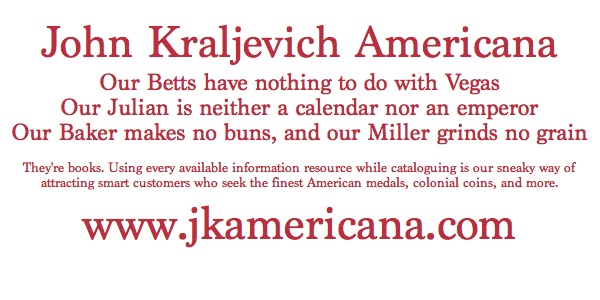
NEW BOOK: GUIDE BOOK OF CIVIL WAR TOKENS, 3RD ED.
The updated and revised third edition of the Guide Book of Civil War Tokens will debut in October 2018. Dennis Tucker of Whitman Publishing submitted this article. Thanks! -Editor
Once Obscure, American Civil War Tokens Now Take the Spotlight
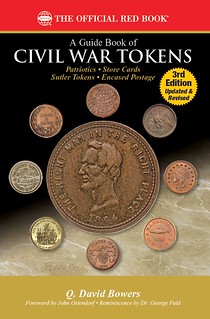 In the early
1940s, young George J. Fuld was first bitten by the coin-collecting bug (as were many other Americans, during a boom in hobby interest that started in the Great Depression). His
conversations with two collectors at the 1947 American Numismatic Association convention sparked a lifelong interest in an unusual and intriguing field: that of Civil War
tokens.
In the early
1940s, young George J. Fuld was first bitten by the coin-collecting bug (as were many other Americans, during a boom in hobby interest that started in the Great Depression). His
conversations with two collectors at the 1947 American Numismatic Association convention sparked a lifelong interest in an unusual and intriguing field: that of Civil War
tokens.
At the time, these tokens were mentioned "but just barely" in the Guide Book of United States Coins, Whitman Publishing's retail price catalog and numismatic history book. First published in 1946, the Guide Book quickly became the most popular annual reference in the hobby, and its contents carried great weight. Inclusion in the so-called "Red Book" meant a die variety or a series was part of the established numismatic world. Civil War tokens made the grade, but without much fanfare, being tucked into a few sentences on page 250 (of 256).
"During the Civil War small coin was . . . hoarded by the public and millions of privately coined tokens were placed in circulation," the Red Book informed its readers. "These are . . . either of political or advertising nature. Some 15,000 different varieties have been discovered, all of which are more or less common. A large majority of the Civil War tokens are about the same size as the present day one-cent piece."
That was the extent of the overview in the earliest editions of the Red Book.
By the 1960s, with a new boom of interest in all things numismatic, that coverage would be expanded with more narrative and a type-table list of values by metallic composition.
In the meantime, in the 1950s, when Q. David Bowers was just getting started as a numismatic force of nature, the hobby's literature on Civil War tokens was still thinner than Abraham Lincoln, and nowhere near as tall"though just as fascinating. Bowers recalls how his education in the field came from a single volume published more than 30 years earlier (Civil War Tokens and Tradesmen's Cards, by George Hetrich and Julius Guttag, 1924), plus the occasional article in The Numismatist and other periodicals, auction-lot descriptions, and, importantly, the personal guidance of hobby mentors.
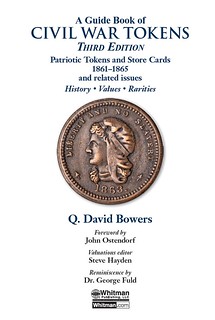
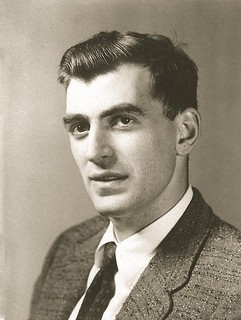
Title page; George Fuld
Among the latter Bowers counted the research team of Fuld and Fuld"son George J. and his father Melvin, by that time well established as experts in the field. Young George had grown up from student to teacher, and he and his father researched and wrote about Civil War tokens through the 1950s. In the early 1960s the Fulds brought into the world the books Patriotic Civil War Tokens and U.S. Civil War Store Cards, produced by Whitman Publishing.
Fred Reinfeld's 93-page The Story of Civil War Money (Sterling Publishing Co., 1959), although not comprehensive, piqued further interest among history buffs. Civil War numismatic historian Fred L. Reed would later credit Reinfeld's book for capturing his imagination. (Beyond numismatics, Reinfeld was a brilliant chess player who introduced generations of players to the game through his beginner-level instruction books.)
Research into Civil War tokens continued, along with the study of encased postage stamps, Confederate currency, and other aspects of wartime money. Numismatists published articles in Numismatic News, Coin World, and other popular periodicals. Over the years the standard references by the Fulds were updated and revised in various new editions.
Bowers wrote his first book, Coins and Collectors, in 1964. It would be the first of many dozens"most of them best-sellers and standard references.
The Civil War Token Society was chartered in 1967. With it, researchers such as Fred L. Reed gained a new "headquarters" for their work in the field, in particular in the publication of the society's Journal. Bowers continued to be a major contributor to research and writing, for the Society and in other venues, while building a huge personal collection of Civil War tokens and buying and selling for his coin- dealership retail customers.
A Dynamic New Publishing Era for Civil War Tokens
I started my work as publisher at Whitman Publishing in 2004. Civil War tokens were always close to the front burner. Bowers was by then Whitman's numismatic director, and on
the cusp of helping launch a modern renaissance in numismatic research and publishing. Still, the Red Book's coverage of Civil War tokens (less than a full page) was not much
more extensive than it had been in the 1960s, although with new color photography and more in-depth pricing.
We worked quickly to expand this coverage. By 2006, with the 60th edition (cover date of 2007), we had three pages including nearly a full page of history, some three dozen color photographs, and pricing for types (by metal), plus a sampling of patriotic and store card tokens (the latter priced by state, plus a dozen representative varieties) in four grades from Very Good to Mint State.
In October 2007 we published 100 Greatest American Medals and Tokens (by Bowers and Katherine Jaeger), a book that featured Civil War tokens prominently. And in June 2008 we published the Guide Book of United States Tokens and Medals, by Jaeger, which included an entire chapter on Civil War tokens.
It was in the fall and winter of 2008 that we first started seriously discussing a full-length book devoted entirely to Civil War tokens. We knew this would be a massive undertaking, but we were inspired by exciting developments within the Civil War Token Society.
"I talked with Steve Tanenbaum this afternoon," I emailed to Bowers on December 17, 2008. "He's one of a 10-person committee, part of the Civil War Token Society, that's spearheading an encyclopedia of Civil War tokens"an update/combination/expansion of information previously only found in Fuld's 1970 guide, the 1975 CWTS update, and Kanzinger's 2001 price guide. They seem to have a very solid and serious committee, headed by a strong organizer (John Ostendorf), everyone is committed to getting it right, they meet regularly online to work and plan, and their academic and genealogical research is diligent."
Dave saw a Whitman book on Civil War tokens as "a magnificent idea" and he would later recall how he "jumped at the chance" to be its author.
Earnest work on the Whitman book would not begin until June of 2012"but once it began, it barreled ahead in full Bowers style, with the Sage of Wolfeboro pulling together his impressive personal archives, marshalling assistance from across the hobby community, and writing, writing, writing. He delivered the fully written manuscript, with thousands of photographs, before the end of that October"a herculean accomplishment in four months. After editing, layout, and printing, the book debuted at the American Numismatic Association World's Fair of Money in August 2013. It was an immediate hit.
A Modern-Day Classic in American Numismatics
The praise earned by the Guide Book of Civil War Tokens is well deserved. In the foreword to the first edition, Fred Reed said, "Not only is Bowers's coverage of
this series broader than heretofore undertaken by any other author, it is also deeper in both its historical and economic references." The venerable Dr. George J. Fuld, too,
weighed in, nearly 70 years after he first learned of Civil War tokens: "No book on how to collect Civil War tokens has ever been as thorough. I expect that it will be a
standard reference for years to come."
The first print run of the first edition sold out within four months, and was followed by additional printings. We released an expanded and updated second edition in December 2014. Now, in 2018, the book has again been updated and improved, in a third edition that will be available in October.
The words of Susan Trask, longtime treasurer (and current president) of the Civil War Token Society, writing in the foreword of the second edition, still ring true: "Whether you are new to the hobby, a seasoned collector, or someone just looking for a comprehensive reference on Civil War tokens, this book deserves a prominent place on your library shelf."
Our hope is that it will inspire another generation of collectors and researchers.
NEW BOOK: CONFEDERATE NUMISMATICA SUPPLEMENT ONE
Author Peter Bertram has published Supplement One in his Confederate Numismatica book series. -Editor
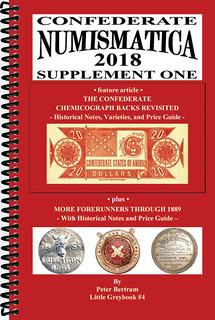
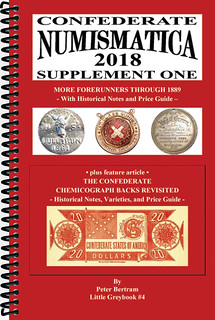
Side 1 / Side 2
Welcome to another installment in the ongoing CONFEDERATE NUMISMATICA series. Each new release will add a little bit more to the body of published information for collectors of Confederate numismatic memorabilia.
This release is a two-sided book — on one side is the section "More Forerunners Through 1889" which continues with the listings started in Confederate Numismatica Part 1. Here are a few highlights…
• A new heading — "Anti-Confederate" Medalets"
• An extremely rare, crudely made "Bull's Run" medal (three known!)
• Raphael Thian's personal Master Album of Confederate notes
• Three more Davis Flight Medals, two with images (total known now 13)
• A superb condition iron Merrimac armor plate token
• Full color images of the extremely rare ACSTD Membership badge (Association of Confederate Soldiers Tennessee Division)
Then flip the book over and the other side offers the feature article "The Confederate Chemicograph Backs Revisited — and here's a few highlights……
• The first detailed study illustrating the 38 known Chemicograph backs and their reverse varieties, grouped in four separate printings as originally produced 1880 to
1958
• Three of Straker's Developmental Essay proofs
• All six of the original Chemicograph printing plates collected by Philip H. Chase
Soft cover, spiral bound, 83 pages. Price $22.00 plus $2.50 shipping : order at www.ConfederateNumismatica.com, or directly from the author at - Peter Bertram : PO Box 924391 : Norcross, GA 30010-4391
Peter will be glad to sign your copy if desired — just request it with your order please…….
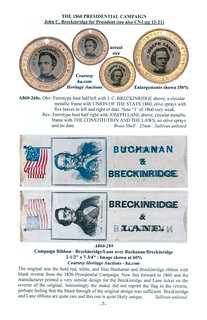
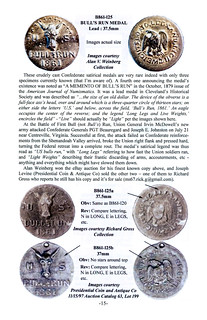
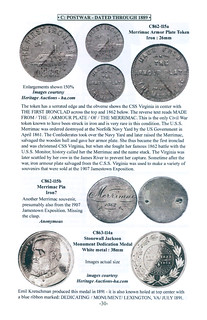
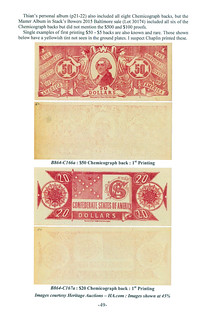
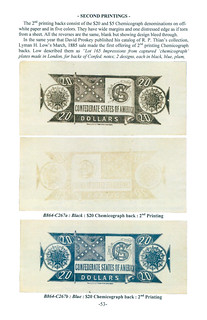
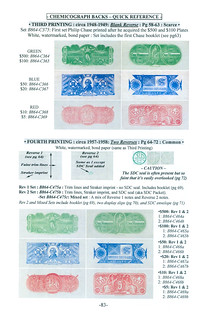
Every bit as well done as his groundbreaking Part One, this supplement provides a great deal of information and photos on this long-neglected but historically important area of American numismatics. Included are three more Davis Flight medals, more on the Stonewall Jackson medals, and for bibliophiles, some information on the Thian and Bechtel albums for Confederate notes.
Peter's first-ever article cataloging the Chemicograph backs by their four printings is thorough and well illustrated (in color). Some of the related numismatic literature is discussed and pictured as well. An important addition to any library on U.S. numismatics. -Editor
To read the earlier E-Sylum articles, see:
NEW BOOK: CONFEDERATE NUMISMATICA, PART 1 (http://www.coinbooks.org/esylum_v19n30a04.html)
BOOK REVIEW: CONFEDERATE NUMISMATICA (http://www.coinbooks.org/esylum_v19n31a11.html)
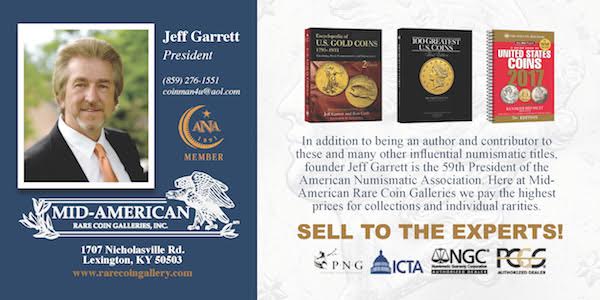
NEW BOOK: COLLECTING WORLD COINS CHINESE EDITION
FW Media has licensed a printing of the 2013 edition of Collecting World Coins to Bejing GW Culture Communications, Ltd. a Chinese firm known for their technical publications and they have translated the text and printed a large (2-3/4 inch spine) but light in weight hardbound edition with dust jacket.
For the collectors of KP editions of the SCWC, this will probably be very hard to acquire in the US market. It comes in at 1055 numbered pages and is priced at 360 yuan ($52.57USD), ISBN 978-7-5478-3671-2.
Interesting! George kindly supplied a number of images. Thanks! -Editor
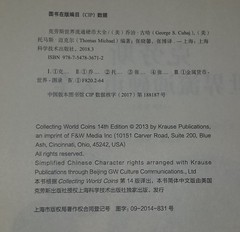
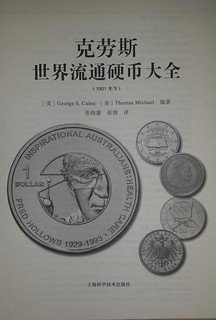
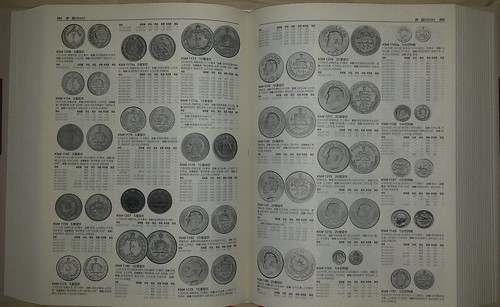
WALTER BREEN's COMPLETE ENCYCLOPEDIA
Dick Johnson submitted these recollections about Walter Breen's Complete Encyclopedia of U.S. and Colonial Coins. Thank you! -Editor
WALTER BREEN CREATES HIS U.S. COIN ENCYCLOPEDIA
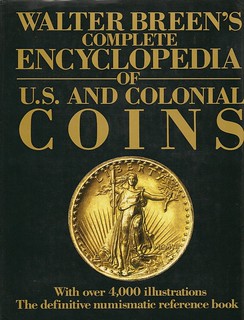 Stanley Afelbaum was the driving force behind the publication of the greatest American
numismatic book. Walter Breen was on his staff as cataloger for his numismatic auctions. Stanley was well aware of Walter's vast knowledge of American coins of every
denomination.
Stanley Afelbaum was the driving force behind the publication of the greatest American
numismatic book. Walter Breen was on his staff as cataloger for his numismatic auctions. Stanley was well aware of Walter's vast knowledge of American coins of every
denomination.
Stanley recognized he could capitalize on Walter's knowledge and what better way than a catalog of U.S. coins. But Walter needed direction and oversight, as Walter was easily distracted.
My knowledge of how he wrote the manuscript may be supplemented by others who recall these events as well.
Stanley established Walter in an empty office in midtown New York City with the essentials to compile the manuscript, including a secretary to do the typing. Walter had a box of notes, but the text mostly came from his experience and extensive knowledge in handling the rarer pieces plus knowing where to find the data on all else.
Walter had a remarkable memory, what some call a "photographic memory." He remembered everything he read, being able to recall this at will. He was a voracious reader. I once asked him what his IQ was. He replied it is impossible to measure it but he estimated it was 180 or more, perhaps over 200 on the Benet scale, where 140 and above is considered a genus.
I don't know how many months he worked on the manuscript, but I can imagine Stanley's persuasion to complete it. My office at the time at Medallic Art Co on East 45th was a few blocks from the unknown location of where Waster was working but I was unable to reach him. I would have been a distraction.
The manuscript was completed, index, appendences and all, by late 1987, and published the following year. The book was relatively free of typos attesting to excellent proofreading. Since publication the most major criticism was mintage figures of some early Mint issues. Where the data was unavailable, it was claimed Walter made it up.
Stanley was a master marketer and Walter Breen's Complete Encyclopedia of U.S. and Colonial Coins sold well. At a New Jersey coin show Walter was seated at a table near the entrance to the bourse room signing copies. A truck outside contained boxes of the book as sales of the book were brisk and a large supply was needed. I was there early the second day. Walter numbered the copies sold at the show. Mine was number 97.
The team of Walter Breen and Stanley Afelbaum created a book unequalled in American numismatics. In 2009 the Numismatic Bibliomania Society conducted a survey among members to name the greatest American numismatic books. The number one choice was Breen's Encyclopedia.
For all the thirty years since its publication it had remained supreme in American numismatics.
To read an earlier E-Sylum article, see:
THE ONE HUNDRED GREATEST ITEMS OF U.S. NUMISMATIC LITERATURE (http://www.coinbooks.org/esylum_v12n25a06.html)

ANA PRESENTS 2018 LITERARY AWARDS
The ANA has announced their literary awards for 2018. Congratulations to the winners! Some familiar E-Sylum names here. -Editor
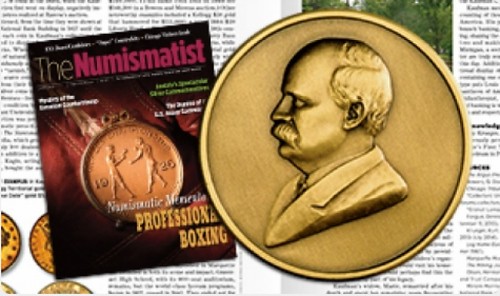
2018 Adult Numismatist Literary Award Winners
The American Numismatic Association's 2018 literary awards — recognizing articles published in the 2017 volume of its official magazine, The Numismatist — will be presented on August 16 at the ANA World's Fair of Money in Philadelphia. The Numismatist was launched by ANA founder and first editor Dr. George F. Heath in 1888, and this year marks its 131st volume.
The Heath Literary Award acknowledges outstanding articles published in the preceding 12 months.
First place goes to Pete Smith, Joel J. Orosz and Leonard Augsburger for "A More Accurate History of the 1792 Half Disme" (August 2017), in which they described Thomas Jefferson's connection with the coin's production. The authors will receive $250 and engraved nickel-silver medals designed in 2013 by artist and ANA member Jamie Franki.
Roger Burdette earned second place ($100 and an engraved bronze medal) for his feature article, "Rescued Rarities" (June 2017), in which he explained how valuable items were recovered and preserved for posterity following the U.S. government recall of gold coinage in the early 1930s.
Allan Schein received third place (an engraved bronze medal) for "The Identity of Pratt's Indian" (November 2017), which postulated that a prominent Brulié Sioux chief was the model for the obverse of Bela Lyon Pratt's early-20th-century gold coins.
The Wayte and Olga Raymond Memorial Literary Award, endowed in 1978 by the late John J. Ford Jr., is presented for articles that display original and comprehensive research in U.S. numismatics.
The August 2017 study by Smith, Orosz and Augsburger received first place ($400), and Burdette's June 2017 work earned second place ($200). David McCarthy garnered third place for "Nova Constellatio: Identifying the First American Coin" (August 2017), in which he demonstrated how die states and historical documents helped identify a prototypical U.S. issue.
Funded by an anonymous donor, the Catherine Sheehan Literary Award for U.S. Paper Money Studies includes $50 for first place.
David Schenkman took the top prize for "Numismatic Mementos of the Glass Industry" (March 2017), in which he spotlighted firms that manufactured and distributed paper scrip or tokens in the 19th and 20th centuries.
Second place (certificate) goes to Ray Williams for "An Evening with Uncle Ray" (September 2017), in which he shared the history and stories behind Early American notes in his collection.
Introduced this year, the Prue and Arthur Fitts Literary Award for Ancient and Medieval Coinage Studies recognizes literary excellence in those fields.
First place ($250) was presented to John Nebel for "Head-to-Head" (August 2017), which illustrated how politics played a big part in ancient numismatics.
Michael Shutterly received second place (certificate) for "In the Beginning" (December 2017), in which he traced the spread of metallic coins throughout the Mediterranean around 650 B.C.
All feature articles published in The Numismatist automatically are considered for the Heath Literary Award; likewise, all qualifying articles are evaluated for the Raymond, Sheehan and Fitts awards. For information about submitting manuscripts for review and possible publication, email Editor-in-Chief Barbara Gregory at gregory@money.org.
The ANA also presents annual awards to encourage young writers and ensure a corps of future numismatic authors and researchers. The Young Numismatist Literary Award categories are named in honor of Whitman authors dedicated to educating the next generation of numismatists. YN Literary Awards were announced at the ANA's Summer Seminar in June.
First place in each category received a $500 cash prize, plus a $500 voucher to help build a personal library of numismatic books produced by Whitman Publishing. Second place received a $200 book voucher and third place received a $100 book voucher. The prizes were provided by Whitman Publishing.
The Bill Fivaz Young Numismatist Literary Award recognizes numismatist writers for ages 8 to 12. First place this year was Caleb Audette for "Confederate Obsolete Banknotes." Second place was Matthew Daum with "The Buffalo Nickel" and the third place recipient was Nikhil Rath with "American Dollar Coins: 1969, 1976 and 2026."
The Q. David Bowers Young Numismatist Literary Award honors numismatist writers that are aged 13 to 17. This year's first place recipient was Paige Price for "Disney Dollars." Benjamin Mous placed second with "Five Reforms, Eight Years: The Coinage of China's Emperor Wang," and Alexander Mous took third with his paper on "The Revival of Local Currency in Japan."
The Kenneth E. Bressett Young Numismatist Literary Award is given to writers between the ages of 18 and 22. This year, first place was won by Cole Hendrickson for "Frontier Forts: Sutlers and Their Tokens." In second place was Jared Lake for his work "Artificial vs. Natural Toning in Silver Coins." Third place was received by Matt Draiss for "Resorts and Melting Pots: The Men & Women Behind the Formation of the Mountains National Bank of Tannersville."
For more information, see:
https://www.money.org/american-numismatic-association-awards
MEET WHITMAN AUTHORS IN PHILADELPHIA
In the spirit of bottom-line-up-front, here's the schedule for author signings at the Whitman booth in this week's ANA show in Philadelphia. Mark your calendars and stop by. -Editor
Arranged by day, the autograph sessions are:
Wednesday afternoon — Bowers and Burdette.
Thursday morning — Bowers, Bressett, and Tucker.
Thursday afternoon — Berk, Burdette, Leonard, and Moy.
Friday morning — Bowers, Bressett, and Burdette.
Friday afternoon — Bowers, Bressett, Leonard, and Standish.
Saturday morning — Bressett and Garrett.

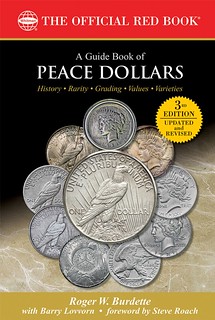
Whitman authors who will participate in book signings include the following. A schedule with specific times will be available at the Whitman booth.
• Harlan Berk (100 Greatest Ancient Coins) " Thursday afternoon.
• David Bowers (A Guide Book of Morgan Silver Dollars; Obsolete Paper Money; etc.) " Wednesday afternoon; Thursday morning; Friday morning and
afternoon.
• Ken Bressett (Money of the Bible; Whitman Guide to Coin Collecting; etc.) " Thursday morning; Friday morning and afternoon; Saturday morning.
• Roger W. Burdette (A Guide Book of Peace Dollars) " Wednesday afternoon; Thursday afternoon; Friday morning.
• Jeff Garrett (Encyclopedia of U.S. Gold Coins, 1795—1933; 100 Greatest U.S. Coins; etc.) " Saturday morning.
• Robert D. Leonard (Curious Currency: The Story of Money From the Stone Age to the Internet Age) " Thursday afternoon; Friday afternoon.
• Edmund C. Moy (American Gold and Platinum Eagles) " Thursday afternoon.
• Michael "Miles" Standish (American Silver Eagles; Morgan Dollar) " Friday afternoon.
• Dennis Tucker (American Gold and Silver: U.S. Mint Collector and Investor Coins and Medals, Bicentennial to Date) " Thursday morning.
Now here's an excerpt from the August 6, 2018 Coin Update article with images from past events. See the complete article online for more. -Editor
Whitman Publishing authors will meet and greet collectors and sign copies of their books at the Whitman booth, #236 (next to the U.S. Treasury Department display), at the American Numismatic Association World's Fair of Money, August 15—18, 2017. The show is held at the Pennsylvania Convention Center at 1101 Arch Street in Philadelphia.

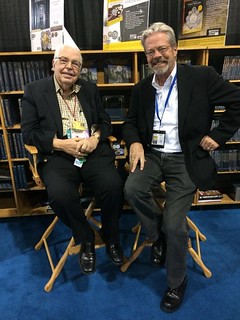
Left: Kenneth Bressett autographs a copy of the 1,504-page Mega Red for Caleb Noel, then news editor (and now managing editor) of the ANA's Numismatist magazine.
Right: Whitman authors Q. David Bowers and Bob Shippee at the 2017 World's Fair of Money in Denver.
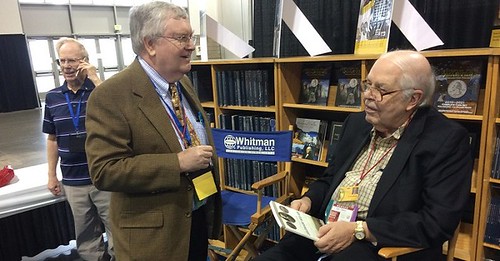
Robert D. Leonard, author of Curious Currency, visits with Q. David Bowers at the 2017 World's Fair of Money. (Longtime Red Book editor Ken Bressett is in the background.)
I'll probably be a frequent visitor myself. Whitman publisher Dennis Tucker and author Dave Bowers will be on hand at the Whitman display and would be delighted to discuss books"new and old"with any E-Sylum readers. -Editor
To read the complete article, see:
Meet your favorite Whitman Publishing authors at the 2018
ANA World's Fair of Money (http://news.coinupdate.com/meet-your-favorite-whitman-publishing-authors-at-the-2018-ana-worlds-fair-of-money/)

MINT TO DISPLAY THREE 1933 DOUBLE EAGLES
This is old news now, but the on-again, off-again U.S. Mint exhibit of 1933 Double Eagles is on again for this week's ANA event in Philadelphia. Here's the Mint press release, to which I've added an image (which may not be of one of the pieces to be exhibited). -Editor
Display will Include Previously Unknown Piece
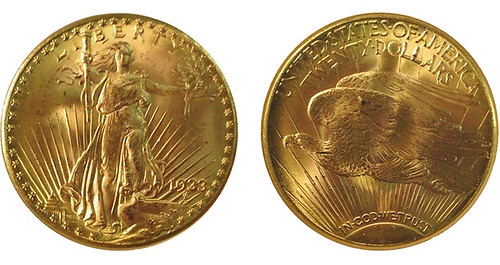
The United States Mint announced today that it will display three of the nation's 1933 Double Eagle Gold Coins in booth 218 at the American Numismatic Association's World's Fair of Money in Philadelphia from August 14 to August 18.
The display will feature two of the ten pieces recovered by the government in 2004. Those coins were the subject of 11 years of litigation, which was resolved last year in favor of the government. The Mint will also display the previously undisclosed specimen that was voluntarily and unconditionally given over to the government by a private citizen who requested to remain anonymous.
In March of 1933, as one of the many measures designed to reverse the Great Depression, President Franklin Delano Roosevelt issued a proclamation prohibiting payment of gold coin. This resulted in the melting of 445,500 1933-dated Double Eagles previously struck at the Philadelphia Mint. Mint records clearly establish that no 1933 $20 Double Eagles were ever issued or released to the public as legal tender. The only specimens to leave the Mint lawfully were two 1933 Double Eagles provided to the Smithsonian Institution for preservation in the National Numismatics collection. Subsequently, one specimen recovered in 1996 became the subject of a unique settlement. The coin was monetized, issued by the United States Mint, and sold at auction in 2002 for $7.6 million.
Unlike nine specimens that were recovered during the 1940s and 50s, none of the specimens in Mint custody will be melted. United States Mint Director David J. Ryder said, "The United States Mint recognizes all of the country's recovered 1933 Double Eagles as national numismatic treasures."
David Gladfelter writes:
What the story doesn't tell us is what will happen to the coins after the exhibit ends. The coins now belong to the people. Shouldn't the people have a say in what's to be done with them?
One idea would be to put nine of them on permanent display at different public locations where security is adequate. (The Smithsonian Institution already has two specimens, so should not receive additional coins.) How about one each at the U. S. Mints in Philadelphia, Denver and San Francisco, and six more at Federal Reserve banks in New York and other locations throughout the country? The tenth one could be kept as a traveling exhibit, at coin shows and the like.
What do you think? What do E-Sylum readers think? Perish the thought of melting them!
Do you know what Federal agency is in charge of them? Maybe that agency would be willing to run a poll. What is this hocus-pocus about "monetizing" the specimen, ex-Farouk, in private hands? Does the Mint have a negative $20 ledger entry for this specimen that's been carried on the books all these years that has to be balanced out? I'm not an accountant — but curious.
I believe the Mint has already committed to not melting the coins. The Mint is part of the U.S. Treasury department, so Treasury would have the final say over them. -Editor
To read the complete press release, see:
Mint to Display Three 1933 Double Eagles at ANA
World's Fair of Money (https://www.usmint.gov/news/press-releases/mint-to-display-three-1933-double-eagles-at-ana-worlds-fair-of-money)
19TH CENTURY NATIONAL NUMISMATIC COLLECTION RECORDS
The latest additions to the Newman Numismatic Portal are 19th century records of the National Numismatic Collection. Project Coordinator Len Augsburger provided the following report. -Editor
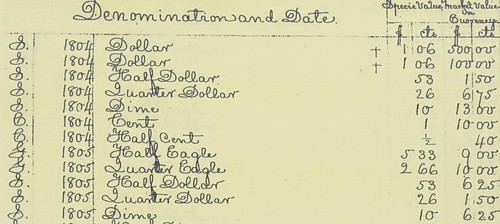
Page from the 1869 Mint Cabinet inventory listing the 1804 dollars
Newman Portal users Saul Teichman and Roger Burdette recently contributed a pair of documents to Newman Portal that provide information on the U.S. Mint Cabinet (today the National Numismatic Collection in the Smithsonian) from the 19th century. Both documents originate from the National Archives & Records Administration (NARA). Thanks to the efforts of Bob Julian, John Graffeo, Roger Burdette, Craig Sholley, and others, the Newman Portal currently contains over 200,000 pages of material scanned at various NARA facilities, including Philadelphia, College Park (MD), and Denver.
The document "Collection of United States and Foregin Coins in the Mint Cabinet at Philadelphia" (from NARA record group 104, entry 160) is a handwritten record, "prepared by the Curators of the Cabinet" in 1869. Interestingly, the catalog provides numismatic valuations of each piece, stating "The…… value is an average of two principal and recent sales — the Seavey and Liliendahl collections at auction; with occasional reference to the Haines and Mickley sales." The curators were thus somewhat familiar with the commercial conditions of the day. Two 1804 dollars are listed (a third was added to the collection later), valued at $500 and $100. The entire collection of several thousand pieces is appraised at "near $20,000." Needless to say today's statistics are substantially increased, on the order of a million pieces and a valuation of a billion dollars.
A second document, from 1887, represents correspondence from Philadelphia Mint Superintendent Daniel M. Fox to U.S. Mint Director James P. Kimball (NARA record group 104, entry 229). Fox writes to Kimball, transmitting a list of U.S. pattern coins from 1794 to date. Although not explicitly stated, this likely represents an inventory of the Mint Cabinet at the time. Fox was clearly aware the list was not comprehensive, stating that he identified 341 pieces, while the Robert Coulton Davis list (published about the same time in Coin Collector's Journal) listed 479 examples. Today, all of this information is available with a quick glance at Whitman's United States Pattern Coins, ably championed by Q. David Bowers and Saul Teichman. Numismatics builds on itself, and today's knowledge is built on these early sources, which represented the best information available at the time.
Link to "Collection of United States and Foregin Coins in the Mint Cabinet at Philadeplhia" (1869) on Newman Portal:
https://nnp.wustl.edu/library/book/553096
Link to 1887 listing of U.S. pattern coinage on Newman Portal:
https://nnp.wustl.edu/library/book/553095
Link to NARA materials on Newman Portal
https://nnp.wustl.edu/Library/Archives?searchLetter=U
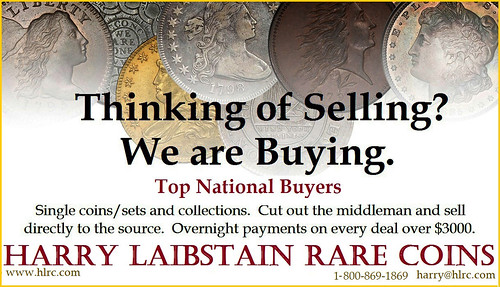
DIE STRIATIONS AND DIE TRAILS
John Regitko submitted these notes in response to last week's question about unusual marks seen on a Kentucky State Quarter. -Editor
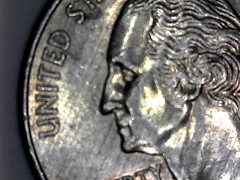
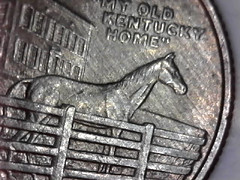
In the last E-Sylum, you mentioned the term "Planchet Striations" with reference to a 2001-P Kentucky State quarter.
A planchet is generally a blank that went through the milling machine to make the blank just a bit smaller and add a high rim around the perimeter. This is also called turning the Type 1 blank into a Type 2 blank planchet. So by using the word "planchet," it implies that the striations were on the blank before it was struck. However, that does not account for the striations to be on the struck coin, since the 200-plus tons of pressure of the dies would flatten any high points on the planchet.
As well, it could not be a planchet problem, since planchet defects are one-of-a-kind (just like double-strikes, off-centers, clips, etc.) and there are a number of these known.
The only answer, therefore, has to involve either from the flow of metal when the planchet was struck, or it was on the die.
How the metal would flow that far is beyond possibility in the split-second that a coin takes to be struck.
That leaves the die as the culprit, in my opinion.
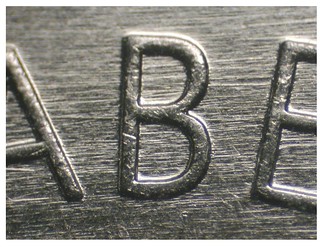 Attached is an image of a
coin that Canadian dealer Nick Cowan of The Coin Collector submitted for my column on errors and die varieties in Canadian Coin News, it is the result of buffing of
the dies after they are chromium plated. This extends their life even more, although buffing his hardly ever used any more today (unlike in 2001) because the repairing of a used
die still gives you a used die and the cost of running off a few more new dies from the master is not that costly.
Attached is an image of a
coin that Canadian dealer Nick Cowan of The Coin Collector submitted for my column on errors and die varieties in Canadian Coin News, it is the result of buffing of
the dies after they are chromium plated. This extends their life even more, although buffing his hardly ever used any more today (unlike in 2001) because the repairing of a used
die still gives you a used die and the cost of running off a few more new dies from the master is not that costly.
You can see lines running in one direction, the direction of the buffing. It is hardly as obvious as the U.S. quarter, so that must have been a heck of a buffing (maybe the worker was really angry that day and took it out on the die?). I am surprised that the good folks at the U.S. Mint would knowingly buff it so much and then actually install it on a minting press, however the Philadelphia Mint was churning out a lot of coins as fast as they could.
Since the presses, technology and procedures are the same in both Canada and the U.S. it would make no difference if it is produced in Winnipeg or at one of the U.S. plants.
Let's see if other subscribers challenge my conclusion!
John Regitko
Columnist, Errors & Varieties, CCN (in my 10th year)
Author, Error & Variety Educational Manual (in my 5th reprint
Sean Moffatt offers these notes. -Editor
I would like to offer some additional information on the die trails and the origin of these lines. For a long time minting "armchair minters" have decided that these lines come from the hobbing process. That is incorrect.
I have been in the minting trade for 30 years. I started out in a die room making and polishing dies, and I still make and polish dies among many other things I have to do on a daily basis. As a young die polisher I put plenty of these trails on dies that I had to fix before sending the die to the press. I now train new die polishers to avoid this mistake, and how to fix it.
The die trails come from inexperienced or over zealous die polishers. The direction of the trails are typically same direction on a coin and typically in random directions between coins made from another die. The hobbing process is just like coining a new coin die. The metal flow is roughly the same, but not as fast as striking a coin. The pressure generated flow lines, if any, will run radially towards the outside diameter of the die. So if these die trails came from hobbing the lines would always be going towards the outer edge of the coin. Again I point out the trail lines go in random directions between different dies.
With this being said, I was a technical advisor to Will Brooks who wrote an article about a year ago (for I think) stating that the die trails could not come from the hobbing process because of what I mentioned above. Although he was not quite sure where they came from die polishing was a suspect in his mind.
I made a video of me polishing a perfectly flat coining die and through intentional over zealousness during the polishing imparted die trails on to the face of the die. I went a little overboard and created some rather large lines. Mr. Brooks still has the die and him and Ken Potter were going to take pictures. The video is kind of rough as I wanted to make it without pausing so no one could claim that I modified the die off camera. Below is a link to the video. I now use this video when training new die polishers as a guide of what not to do.
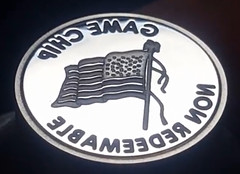
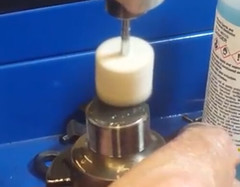
Before and During polishing

After polishing
To watch the video, see:
(https://drive.google.com/open?id=0Bw4Q1NCUjY_aeUFsNUtSMlpLdU0)
Thanks, everyone! -Editor
To read the earlier E-Sylum article, see:
NOTES FROM E-SYLUM READERS: AUGUST 5, 2018 : Query: U.S. Quarter Information Sought
(http://www.coinbooks.org/v21/esylum_v21n31a15.html)
DIE ADJUSTMENT STRIKES
On a related note, here is an August 10, 2018 post from the The Australian Coin Collecting Blog about die adjustment strikes. -Editor
For coins to be made the dies need to strike together at force to transfer those designs into the metal blank surface. It takes between 35 and 200 tonnes of pressure to strike coins and this varies with each coin denomination and if it's a proof coin or a circulation strike. When the press is setup with new dies a touch series is often made increasing the pressure with each coin struck to decide which tonnage will be used in that production run to make the perfect coin and get the most use out of the dies.
Coins struck with a lower than optimal pressure show poor definition and are labelled die adjustment strikes. This can also happen if there is a press malfunction anytime within the production run, a low pressure strike causing weakness in the coin design. This happens uniformly around the obverse and reverse and is generally the same on both sides of the coin.
To give you some idea of striking pressure it takes 35 tonnes of pressure to strike a $2 coin. It takes 140 tonnes of pressure to strike a larger 50 cent coin. The image below is of a touch series of 20 cent pieces with the weaker strikes (5 tonnes) top left increasing to the stronger strikes (120 tonnes) bottom right.

To read the complete article, see:
Coin Striking Pressures — a Touch Series of Die
Adjustment Strikes (https://www.australian-coins.com/error-coins/coin-striking-pressures-touch-series-die-adjustment-strikes/)
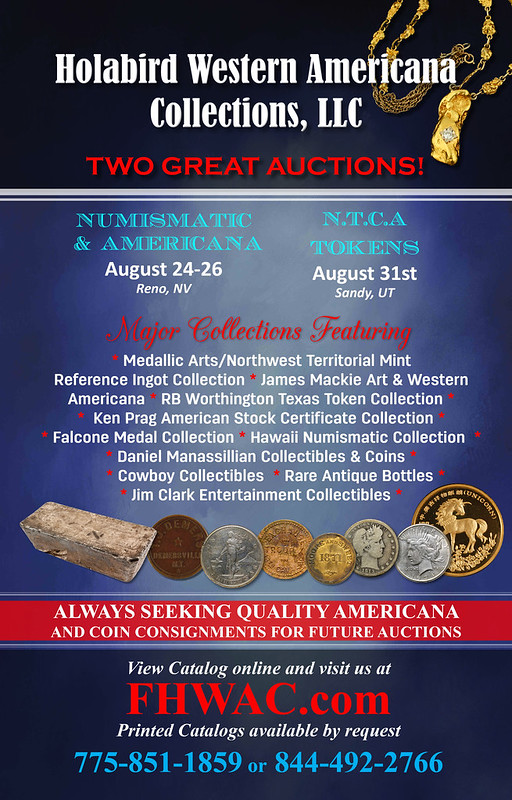
NOTES FROM E-SYLUM READERS: AUGUST 12, 2018
Bill Rosenblum Remembers Mike Metras
Bill Rosenblum writes:
I was saddened to learn of the passing of Mike Metras. He took my class on Biblical Numismatics at the ANA in the mid 1990s and we stayed in contact for awhile after that. For awhile he would send me, either by email or snail mail, tales of his travels, links to his writings etc. He will be missed.
To read the earlier E-Sylum article, see:
MICHAEL METRAS (1943-2018) (http://www.coinbooks.org/v21/esylum_v21n31a08.html)
A Thank-You From David Pickup
David Pickup writes:
Please pass on my thanks to the readers who helped identify the cuttings. I handled the book last week and have begun to go through it. It seems to have been written in 1710s. There are more cuttings and drawings in it. It will take me awhile to go through it. Thanks again.
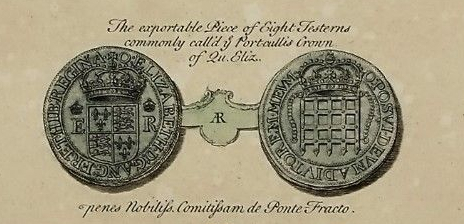
From Plate 56 of Volume I of "Vetusta Monumenta ..."
Ron Haller-Williams and Julia Casey did an amazing job of locating the source of the book cutting David asked about. E-Sylum readers are the best! -Editor
To read the earlier E-Sylum article, see:
BOOK CUTTING ANSWER: VETUSTA MONUMENTA (http://www.coinbooks.org/v21/esylum_v21n31a16.html)
On Slabbing Medals
Regarding the slabbing of medals, Joe Foster writes:
As a collector of medals of the French Regime in the New World by Betts, I have run across several of these medals that are slabbed. I won't express a view on slabbing, except to say I have purchased a few, 2 or 3, I think... and I have cracked them out of the cases.
If these grading services are going to slab medals, I think that they need to give more information; with these medals you need to know: are the edges beveled, filed, rounded, square edge, plain edge restrikes, or restrikes? If a restrike, one needs to know what the edge mark is: ie: cornucopia, bee, pointing hand, prow of a galley/ship, anchor and without this information one cannot tell anything about the medal.
They should be mounted in a holder where the edge is visible and information is properly noted. Medals are far different from coins.
I don't collect coins; never have, only Canadian tokens and now, medals. That's it !!! I'm not against slabbing, as folks have a right to do what they want - it's just not for me!!!!
Slabs aren't my favorite things either, but they do serve a purpose and are certainly here to stay. But Joe's quite correct that more information is needed for things like medals. -Editor
Breen's "Bristles and Barbs"
Dave Lange writes:
Regarding Len Augsburger's suggestion that the Walter Breen "merde" tale may be apocryphal, perhaps it didn't make it to final print but was stopped when noticed by Coin World's editor. That still could have been grounds for firing, since it was probably not the first time Breen ruffled some feathers there. The name of his column, "Bristles and Barbs," says a lot about its content.
Though CW dropped Breen's column in 1965 it was picked up by Krause Publications' COINS Magazine shortly afterward and ran under the same title for several more years. This is where I first saw it when I began reading coin periodicals about 1970.
Good points. A collected set of the columns would be interesting reading! -Editor
To read the earlier E-Sylum article, see:
READER THOUGHTS ABOUT BREEN AND COIN WORLD (http://www.coinbooks.org/v21/esylum_v21n31a13.html)
A Library is a Terrible Thing to Waste
Douglas Saville writes:
Having read George Kolbe's recollections about conditions of books prompted me to recall the time when I was at Spink's, and it must have been in the mid-1970s, when I was asked to visit a rather grand house, or, rather, mini palace, in a very smart part of London. The owner, I was told, was a Maharajah, or was it a Maharanee ?, from an Indian State, who had a "beautiful library of many hundreds of books on all kinds of subject….", and the main point was that they were all in "fantastic and wonderful leather bindings". They had been brought back from India, and more importantly, the owner wanted to sell them.
At the time I was dealing in all kinds of rare books at Spinks - we had published 5 or 6 catalogues of such books and we, that is Spink, were gaining a reputation for handling good things…… Anyhow, I made an appointment, visited the house, and was shown into the dimly-lit library. It looked fantastic - at a first glance……. And I started to wonder just how we could handle such a treasure-trove…
Then I began to take a volume or two off the shelves….. and, to my horror, they were all, yes, all, were eaten by worms, termites, and all manner of undesirable creatures, and the bindings and all the contents were destroyed, rending the "wonderful library" worthless. The big lesson I learned was that one must look at everything, when one is looking at a library - the chance is one might find treasures, but on the other hand, life can be full of disappointments.
How sad! A library is a terrible thing to waste. -Editor
To read the earlier E-Sylum article, see:
NOTES FROM E-SYLUM READERS: JULY 29, 2018 : The John S. Davenport Library
(http://www.coinbooks.org/v21/esylum_v21n30a11.html)
 Buffalo Nickel Word Jumble
Buffalo Nickel Word Jumble
Loren Gatch writes:
Since you are running "Family Circle" cartoons, here's the Jumble from today's paper, with some numismatic content. I won't spoil it! But I will send the answer next week.
Thanks. Bill Hyder submitted this as well, with his answer filled out. But we'll wait for next week so folks can have some fun with it. Good luck. -Editor
A Big Mac Predecessor
Regarding the anniversary of the Big Mac, Larry Dziubek writes:
You may be too young to remember Winky's. When I was a lifeguard in 1962-63 we got BIG WINKS at Winky's on McKnight Road on the way back from North Park. Delligatti may have changed the sauce recipe slightly, but otherwise the bun and two patty structure was the same. He was not an inventor but merely put the Chinese adoption method to work for himself.
For better or worse, I am old enough to remember the Pittsburgh-area Winky's hamburger chain and the Big Wink. I miss it! They went out of business in the 1970s. -Editor
For more information on Winky's, see:
Remembering Pittsburgh's Winky's Burger Franchise
(https://www.pghcitypaper.com/pittsburgh/remembering-pittsburghs-winkys-burger-franchise/Content?oid=8223080)
Winky's (https://en.wikipedia.org/wiki/Winky%27s)
To read the earlier E-Sylum article, see:
MCDONALD's ISSUES 50TH ANNIVERSARY BIG MAC COINS (http://www.coinbooks.org/v21/esylum_v21n31a40.html)
In the better-than-a-token-good-for-a-Big-Mac department, Dick Hanscom forwarded this Daily Mail item about -Editor
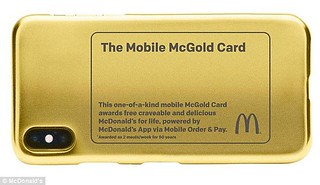 The elusive McDonald's 'McGold
Card' has enjoyed mythical status for years, with fans of the fast food chain only getting glimpses and hints of its existence.
The elusive McDonald's 'McGold
Card' has enjoyed mythical status for years, with fans of the fast food chain only getting glimpses and hints of its existence.
But this week, Micky D's confirmed that it does, in fact, exist.
In fact, the company is giving away one of the highly-coveted VIP cards, offering one very lucky customers free food for life.
To read the complete article, see:
A McMust-Have! McDonald's reveals it is giving
away a highly-coveted 24K McGold Card to ONE lucky customer - who will be entitled to two free meals a week for LIFE
(http://www.dailymail.co.uk/femail/food/article-6044345/McDonalds-giving-away-McGold-Card-entitled-free-food-LIFE.html)
The Seven Cent Nickel
Bruce Smith writes:
Groucho also had a plan for a seven cent nickel.
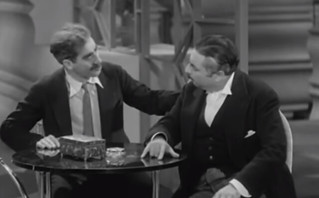
To watch the video, see:
Seven Cent Nickel (https://www.youtube.com/watch?v=H0K3QtU-iNM) : Flavors of the U.S. Mint
To read the earlier E-Sylum article, see:
NOTES FROM E-SYLUM READERS: AUGUST 5, 2018 (http://www.coinbooks.org/v21/esylum_v21n31a15.html)
THE THIRTEENTH LABOR OF HERCULES
Dick Grinolds submitted these notes on an iconic image on some great medals. Thank you! -Editor

Nitroglycerin Corporation medal
The dealer profile story about Jeremy Bostwick illustrated a Swedish medal commemorating the 75th Anniversary of the Nitroglycerin Corporation picturing a nude male strenuously opening a crevice between two rock walls. This theme of intense effort immediately brought to mind a 1979 medal commemorating the 75th Anniversary of the beginning of construction of the Panama Canal that I recently sold.
This large 3" diameter bronze piece also honors the 1915 Panama-Pacific International Exposition held in San Francisco which, according to So-Called Dollars authors Harold Hibler & Charles Kappen, had a three-fold purpose: 1) to celebrate the opening of the Panama Canal, 2) to commemorate the 400th Anniversary of the discovery of the Pacific Ocean, and3) to celebrate the rebuilding of San Francisco following the 1906 earthquake and fire.
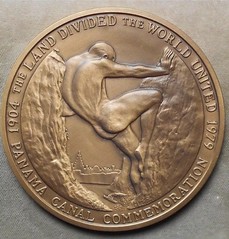
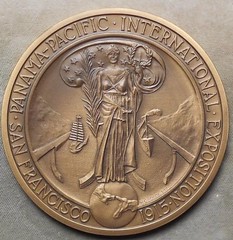
1979 Panama Canal 75th Anniversary Medal
This medal is signed Nahl Hyde sc. on the obverse and W.C. Roddy 1979 on the reverse.
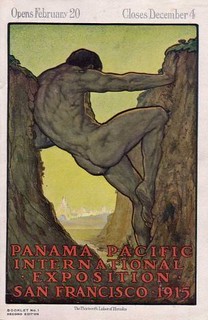 The image of
the male in the crevice will be very familiar to collectors and enthusiasts of the 1915 Pan-Pac Exposition as the image was used on several promotional items including large expo
advertising posters and one of the official guide books to the exposition. It is sometimes titled "The Thirteenth Labor Of Hercules". I feel fairly certain that
E-Sylum readers will be able to recall earlier works that may have inspired the 1915 rendition what with the numerous Samson, Atlas, Hercules and other strong man themed
numismatic items as well as other artistic works in our past.
The image of
the male in the crevice will be very familiar to collectors and enthusiasts of the 1915 Pan-Pac Exposition as the image was used on several promotional items including large expo
advertising posters and one of the official guide books to the exposition. It is sometimes titled "The Thirteenth Labor Of Hercules". I feel fairly certain that
E-Sylum readers will be able to recall earlier works that may have inspired the 1915 rendition what with the numerous Samson, Atlas, Hercules and other strong man themed
numismatic items as well as other artistic works in our past.
To read the earlier E-Sylum article, see:
NEW DEALER PROFILE: JEREMY BOSTWICK (http://www.coinbooks.org/v21/esylum_v21n31a23.html)
Panama-Pacific-Int-039-l-Expo-Panama-Canal-PPIE-Commemoration-75-Years-1904-1979
To read the complete eBay lot description, see:
(https://www.ebay.com/itm/Panama-Pacific-Intl-Expo-Panama-Canal-PPIE-Commemoration-75-Years-1904-1979-/123290221039?oid=223069757084)
VOCABULARY TERMS: METAL FLOW, FLOW MARKS
Dick Johnson submitted these entries from his Encyclopedia of Coin and Medal Terminology. Thanks. -Editor
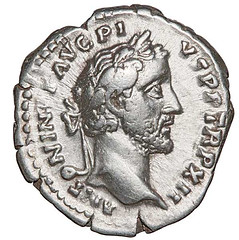

Flow marks on a silver denarius of Antoninus Pius, from Forum Ancient Coins.
See: Flow Marks and Halos on Roman Coins.
Metal Flow. The movement of metal in a blank at the instant of striking as it flows into the cavities of the dies under pressure during striking in a press. Metal flow is this metal movement, the result is called DISPLACEMENT. Metal flow occurs throughout the mass of the blank, but is most severe at and near the surface. SURFACE DISPLACEMENT is the metal flow that creates the design, where the metal flows into all the contours and cavities of both dies. Metal flow can also (but not always) cause microscopic surface striations, parallel ridges and channels, generally from the outer rim inwards as the metal is displaced to the area of the greatest cavities of the dies. These striations, FLOW MARKS, are the cause of LUSTER, and, very infrequently, CARTWEEEL EFFECT.
The pressure at the instance of the BLOW to the blank is the power that generates metal flow. It is so strong during striking in a press that it can move metal deep within the mass of the blank. The surface metal that flows into the die cavities is replaced by adjacent metal, and this, in turn moves its adjacent metal. The movement continues until both surfaces of the blank fit the shape of both dies.
Metal flow stops at the instant the dies are fully extended and there is no more pressure. However, in rare instances, as the dies retract some metal may spring back somewhat
(by MOLECULAR MEMORY) and cause DIE DRAW. This is cured in coining with a slightly stronger impression. See also STRIKING, SUCTION.
CLASS 06.5
Flow Marks. Minute striations or corrugations on the surface of a freshly struck coin or medal. Flow marks are caused by the surface displacement of metal as the piece is struck, generally forming a microscopic pattern of ridges and channels — appearing to the naked eye as radial lines — which tend to form from the center outward toward the rim. They are best viewed in the field where no relief is present.
Flow marks on a struck piece are the cause of LUSTER (also called MINT LUSTER) by reflecting light in a distinctive way; it is also the cause of CARTWHEEL EFFECT. The slightest wear or handling will diminish or erase flow marks (the minute channels fill with dirt, grease, human perspiration, oils, other contaminates or fluids the piece has come in contact with). This reduces the surface metal's unusual reflective quality, tarnish and wear begins.
Flow marks disappear rapidly as coins circulate or are handled; because of this they are an excellent criteria to distinguish true uncirculated pieces. (Collectors call the existence of flow marks a DIAGNOSTIC of MINT STATE where the piece has never been mishandled or circulated.)
In addition to wear or handling where contaminates fill the channels, any type of processing — polishing or whizzing — will remove flow marks. There is no known method of artificially returning flow marks once they have disappeared. They are very fragile, and once gone, cannot be restored.
Flow marks can be seen under low power magnification (3x to 10x) but are even more obvious under greater magnifications. Flow marks do not appear on proof coins because of the smooth polished surfaces, of both dies and planchets. Likewise in medallic work, any flow marks are removed by the finishing process. Thus flow marks are characteristic of uncirculated coins only.
White metal flow marks. An unusual situation exists for certain white metal alloys with high TIN content. Flow marks on such pieces, where the METAL STRESS is the
greatest, will not tarnish but remain bright forever. The surface of certain white metal medals exhibit this phenomenon; the remainder of the piece will TONE or TARNISH (actually
turn dark gray to black), but the flow mark high stress areas will remain bright. Thus the bright area is a reverse bright "shadow" in contrast to the naturally dark
toned surface. See WHITE METAL.
CLASS 06.5
Looking for the meaning of a numismatic word, or the description of a term? Try the Newman Numismatic Portal's Numismatic Dictionary at: https://nnp.wustl.edu/library/dictionary
Or if you would like a printed copy of the complete Encyclopedia, it is available. There are 1,854 terms, on 678 pages, in The Encyclopedia of Coin and Medal Technology. Even running two a week would require more than 19 years to publish them all. If you would like an advance draft of this vital reference work it may be obtained from the author for your check of $50 sent postpaid. Dick Johnson, 139 Thompson Drive, Torrington, CT 06790.

WILLIAM KLAHR MILLER (1842-1923)
 William Klahr Miller
(1842-1923), was born the third of ten children on July 5, 1842 at Strausstown, Pennsylvania, son of Michael Mathias Miller (1814-1881), and Catherine Klahr Miller
(1817-1915).
William Klahr Miller
(1842-1923), was born the third of ten children on July 5, 1842 at Strausstown, Pennsylvania, son of Michael Mathias Miller (1814-1881), and Catherine Klahr Miller
(1817-1915).
From November 1862 to July 1863, he served as a drummer and second musician with Company H 151st Pennsylvania Infantry. He was active in the engagement at the Battle of the Wilderness, and the Battle of Gettysburg.
In 1875, he married Emma E. Liess (1853-1927). They had no issue.
In the 1879-1886 Reading City Directories he is listed working variously as a clerk, cloth salesman, and paper bag maker living at 125 1/2 Reed Street, Reading, Pennsylvania. He is noted as one of the eldest surviving employees of 21 years at Dives, Pomeroy, and Stuart Department Store, later on in 1923 known as Pomeroy's Inc. He worked there until late 1922 when taken ill.
Miller was active in the late 1870's and throughout the 1880's as a part time coin dealer. He was also a well-noted angler catching many black bass some 19 inches long.
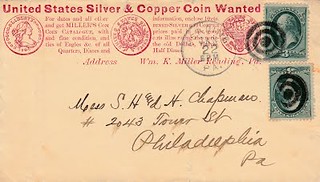 In June 1879,
he sold rare silver and copper coins to Ebenezer Locke Mason, Jr., and to the Chapman Brothers silver and copper coins.
In June 1879,
he sold rare silver and copper coins to Ebenezer Locke Mason, Jr., and to the Chapman Brothers silver and copper coins.
In July 1879 he advertised in Numisma, Vol. 3, No. 4, page 1.
He was listed as a coin dealer wishing correspondence in Mason's Coin Collector's Herald, June, 1879.
He attended Charles Steigerwalt's third coin auction on December 22, 1881, in Lancaster, Pennsylvania, where he met Ebenezer Locke Mason, Jr., George B. Massamore, Gayland from Rawlingsville, Pennsylvania, and Frank Dietrich from Harrisburg, Pennsylvania.
In the July 1882 issue of Numisma he advertised his Miller's Silver and Copper Coin Catalogue with Illustrtaions of the Large and Small Eagle Varieties of Old U. S. Coins.
He died of chronic nephritis one day after his 81st birthday in 1923 at the Homeopathic Hospital after being bedridden for eleven months previously at home. He is buried at Zion Lutheran and Reformed Cemetery, Womelsdorf, Berks, County, Pennsylvania.
To read the complete article, see:
MILLER, WILLIAM KLAHR
(https://sites.google.com/a/numismaticmall.com/www/numismaticmall-com/miller-william-k)
The entire inventory of the Lupia Numismatic Library is for sale. Individual items will be available before the remaining archives are broken up into parcels sold at philatelic auctions in the U. S. and Hong Kong. Check NumismaticMall.com frequently as dozens of new items with estimates will be posted daily until everything is sold.
All inquiries will be given prompt and courteous attention. Write to: john@numismaticmall.com .
JOHN E. HERZOG: FRIEND OF FINANCIAL HISTORY
Bruce Hagen's August 8, 2018 post on his Stack's Bowers blog discusses John Herzog, founder of the Museum of American Finance. -Editor
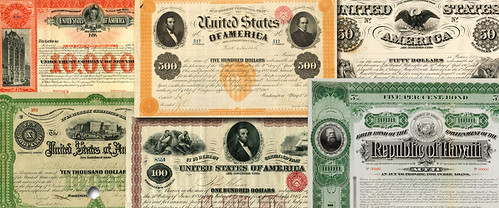
When our Stack's Bowers Galleries' clients, scholars, John's friends and family and others glance at or study closely the pages of this catalog section, they are witnessing the ongoing passion of a transformative collector in this or any other era. Though we convene this event at the ANA World's Fair of Money, the following 101 items, many offered for the first time or in multiple decades, represent just a part of John's amazing collection of financial history and numismatic items and the spirit with which he acquired them.
When I first met John and Diana Herzog in 1985, financial history was a subject that seemed contradictory to my numismatic pursuit of United States Obsolete banknotes. It has taken these 33 years for me to realize the transformative role John has played in my passion for collecting, cataloging, and enjoyment of all financial instruments and the significance of their use in commerce and culture.
John's decades-long passion for collecting and understanding these historic treasures inspired his vision and eventually fulfilled the dream of a permanent Museum of American Finance (a Smithsonian affiliate), located within the steel canyons of Wall Street and the birthplace of the American capital markets. The museum evolved from wall exhibits, to a small museum and gift shop in the ground floor hallway at 26 Broadway (Rockefeller's Standard Oil Building), to its stately open air gallery at 48 Wall Street. Visitors have the opportunity to enjoy the experience that John wishes to share about the significance of financial history and its relevant artifacts.
The bond certificates, United States Interest Bearing notes (sold within the main body of this session and pedigreed to the Herzog Collection), documents, and related items cataloged in this auction mirror the times they were issued. This sale covers items issued from 1837-1919. Most were for the financing of war and conflict. Even in the late 1840s, the United States was young and vulnerable. The idea of Manifest Destiny to populate the continent merged into the Civil War and the creation of fiat currency and many different loan issues. The National Banking system and its currency notes were backed by bond purchases.
Essential funding toward the end of the Civil War saw rising interest rates and favorable terms for investors to sell notes and redeem them for gold. After the Civil War, relative calm and peace brought about ambitions for American expansion overseas, where vulnerable European nations with dwindling empires could be replaced by American mercantilism. Hawaii became our 50th state because we believed that was a better idea for everybody in 1893. The Spanish colonial empire was collapsing in the 1890s and the sinking of the U.S.S. Maine made Teddy Roosevelt famous and created low denomination Treasury Bonds aimed for public sale to support war efforts. The most significant public financing by the United States was for World War I, where five issues of loans were created to sell to the public and investors in a three-year span to fund this war. John's collection of these bond certificates is the finest and most comprehensive ever cataloged for sale.
It was exciting to be called upon to catalog this special presentation of the John E. Herzog Collection for Stack's Bowers Galleries. It allowed me over the course of research and writing to reflect how transformative a person John has been to me. I realized how much of a story the items themselves have to tell. When John and Diana hired me, in early 1989, to work at R.M. Smythe & Co., I never imagined that someday I would have the honor of presenting these to the collecting community. Everyone should be thankful for John's generous spirit, his creation of the museum, the sharing of his passion for numismatics and collecting, and the friendship he has shown to so many of us for decades. He truly is "The Friend of Financial History."
To read the complete article, see:
John E. Herzog: The Friend of Financial History
(http://www.stacksbowers.com/News/Pages/Blogs.aspx?ArticleID=3070)
TED BINION AND THE BINION SILVER DOLLAR HOARD
From the Jacksonville Progress of Jacksonville,TX comes this backstory on the Binion Hoard of U.s. Morgan and Peace dollars. Here's a short excerpt - see the complete article online. -Editor
On display in your Vanishing Texana Museum is a 1884 Morgan silver dollar, part of a poker collection on loan from Mr. Frank Graham of Tyler, TX. The coin is encapsulated in a plastic holder with a unique white and green label. The holder and label were provided by the Numismatic Guaranty Corporation, the world's largest and most trusted third-party coin grading service, as part of their contract to authenticate the coin as part of the "Binion Hoard." So, what is the Binion Hoard and how did a part of it end up in our museum?This coin's heritage begins in Dallas, TX and involves drugs, love, greed, betrayal, and murder all with the background of Las Vegas, NV.
A man named Benny Binion became part of the Dallas gambling and racketeering world in Dallas starting in 1924. In 1946, the Dallas City Attorney vowed to send Benny to jail for his crimes, so Benny packed up two million dollars in cash and relocated to Las Vegas where he purchased two casinos. He combined them into a new business called Binion's Horseshoe Casino. His youngest son, Ted, worked odd jobs at the casino and earned a reputation for his knowledge of the gambling industry and casino operations.While growing up around casinos, Ted developed an "appreciation" for coins, especially silver dollars. According to the April, 2002 edition of "The Numismatist", Ted believed a dollar bill was merely questionable paper promise printed by politicians. Silver, he believed, had proven its value is real currency since Biblical times (for examples see the ancient coin exhibit in the museum) and could be relied upon to keep its value.
He especially loved the Morgan and Peace silver dollars which he stored in a special vault at the Horseshoe Casino. Ted' s fondness for young women also continued and soon he meets Sandy Murphy.Sandy Murphy was a local Southern California girl looking for a change when she emptied her bank account and headed for Las Vegas. What happened to Murphy in Nevada is classic Vegas noir. She lost all her money, took a job stripping and modeling lingerie, and met casino owner Ted Binion when she was modeling a Dallas Cowboys Cheerleader outfit. Murphy moves into Ted's 8500 square foot home complete with a Mercedes sports car and a credit card with a $10,000 limit.
Along with money and fast women, Ted also became addicted to drugs. It was the drugs and some financial irregularities at his casino that led the Nevada State Gaming Commission to suspend his gambling license. Ted was forced to sell his beloved Horseshoe and had to move his silver coin hoard out of the casino. He decided to build a large underground vault on an undeveloped piece of property he owned in near Pahrump, Nevada.
To read the complete article, see:
Mysteries at your Museum:
Love, greed and betrayal (http://www.jacksonvilleprogress.com/opinion/mysteries-at-your-museum-love-greed-and-betrayal/article_e932676a-9768-11e8-9bfa-5b63b8b6f5f9.html)
For more information on the Vanishing Texana Museum, see:
Vanishing Texana Museum (https://vtmjacksonville.org/)
To read the earlier E-Sylum articles, see:
BINION SILVER DOLLAR CASE CONTINUES (http://www.coinbooks.org/esylum_v08n21a02.html)
VERDICT IN BINION CASINO MURDER CASE (http://www.coinbooks.org/esylum_v13n05a16.html)
QUERY: ST. LOUIS POST OFFICE TOKENS
Bruce W. Smith submitted this request for information on the St. Louis Post Office tokens. Can anyone help? Thanks. -Editor
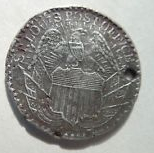
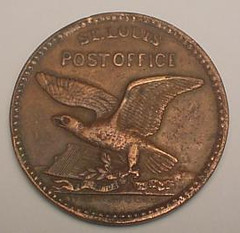
Thanks for another fine E-Sylum. I am hoping your readers can help me locate any photos or scans of any of the St. Louis Post Office tokens. These tokens were listed in the old Donald Miller catalog of early US tokens as numbers 29 - 35. Rulau also lists them as under the Miller numbers in the U.S. Merchant Tokens section of his Standard Catalog of United States Tokens. These tokens have an eagle and shield design on the obverse. The reverse is blank, except for a hand engraved name of some business. I have recorded a couple dozen different names on these tokens -- all of which are unique. The listings, however, are confused, mostly based on vague descriptions. I suspect there are only two varieties of these tokens as follows:
A. Eagle above shield with flags to sides. Maker's name: J. M. Kershaw at bottom of reverse. white metal 25mm
B. Eagle standing on prostrate shield (laying on ground). Maker's name: Stubenrauch & Weber at bottom of obverse. copper 28mm
Rulau says two of these tokens appeared in auctions in 1850 and 1856, but doesn't say which one. Kershaw was in business from the 1840's into the early 1880's, and is best known for engraving the St. Louis Post Office provisional stamps during 1845-1846 (see David Schenkman article in Numismatist December 2015). Stubenrauch & Weber were only in business during 1863-1864 (perhaps a year earlier and/or later), during the Civil War. This makes their design of a prostrate shield appropriate.
From this information it is clear these pieces were used from the 1840's into the 1860's. What is not clear is whether all these tokens carry the maker's name or whether some are unsigned. Therefore I need to see images. I thought Google Images would pull up several images, but it only brought up three -- two copper pieces (one in the Eric Newman collection), and one white metal piece which I recently bought on eBay. And I have also seen the white metal piece in Schenkman's article. All of these four pieces are signed. Can anyone direct me to (or send me) images of these pieces? If you own one and want to remain anonymous, that is fine. I just want an image or a full description (does it have the maker's name?) including the engraved name.
QUERY: PEARL HARBOR VETS CONGRESSIONAL MEDAL DIE
Peter Huntoon passed along this inquiry from Thomas Mcanear at the National Archives and Records Administration (NARA). Thanks. -Editor
I have an inquiry from a Congressional Research Service Specialist on the following:
"I have a question regarding the Congressional Medal for Veterans of the Attack on Pearl Harbor. Authorized by P.L. 101-510, §1492 (104 Stat. 1721, November 5, 1990), the legislation authorized the Secretary of the Treasury to design and mint bronze medals. In total, approximately 33,000 medals were minted.
"I have a congressional client who has inquired about the location of the die used to strike the medals. The US Mint does not know where the die might be, so I wanted to inquire with the National Archives in case you had the die or any of the surrounding artwork that might be associated with this coin program."
We don't have the die of course, but I thought one of your connections might know about the die? Or the artwork associated with the Medal?
We're all confused as to what the U.S. Mint wouldn't know where its own die is. That's 28 years ago to be sure, but isn't there a handy die vault for such storage? Peter passed the query along to me and American Numismatic Association museum curator Doug Mudd. -Editor
Doug writes:
I am not aware of such a die or of any artwork related to it at the National Numismatic Collection. I do know that the few US Mint dies that were in the collection were cancelled. I was only aware of a couple of presidential dies - and no artwork other than that related to Morgan and the Barbers' notebooks.
Can anyone help? I'll send the query to contacts at the NNC, but I suspect all roads will lead back to the Mint. Meanwhile, does anyone have images of the medal? -Editor
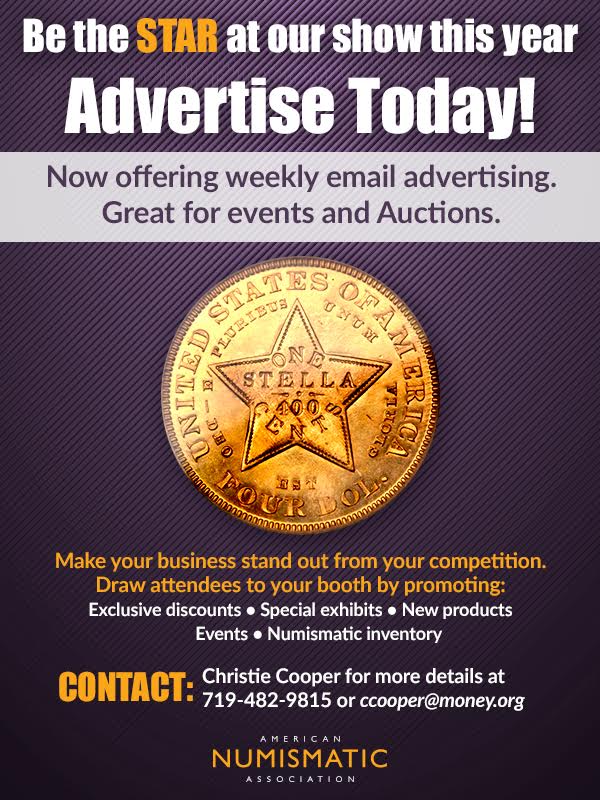
DAVE BOWERS ON COLLECTING CIVIL WAR MONEY
Forming a collection of money used during the Civil War can be an interesting pursuit. A full collection of such would include tokens, coins, and paper money and would run to over 1,000 varieties if scrip or private paper money notes were considered. A bit simpler plan is to have a type set showing representative examples of each of the major categories of money or money substitutes. Such a display would attract a lot of attention at a coin club meeting or attention. No area of American numismatics is as diverse!
This would include the following:
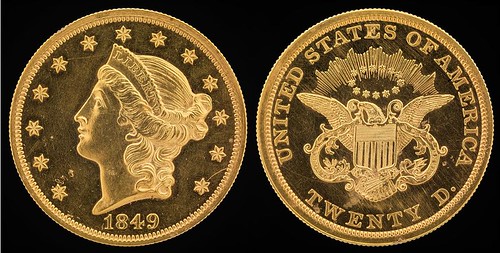
Federal coins ranging from the Indian cent to the Liberty Head double eagle. Denominations in copper and silver are easily enough obtained, plus the first nickel alloy coin, the three-cent piece of 1865. Gold coins include the $1, $2.50, $3, $5, $10, and $20, and can be a bit expensive. In any of these Civil War money categories, you can have just one example or you can have many, depending on your budget.
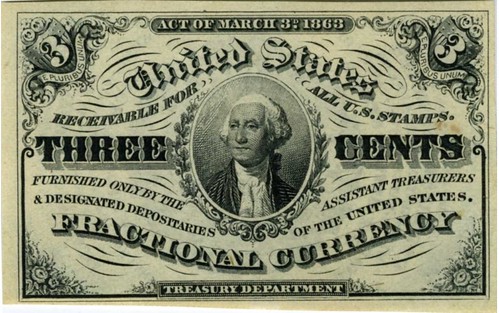
Federal paper money includes Postage Currency and Fractional Currency notes of denominations from three cents to 50 cents. One denomination of each of the two series would make a nice display, or you can show the various denominations, including the unusual value of 15 cents. These are colorful and inexpensive.
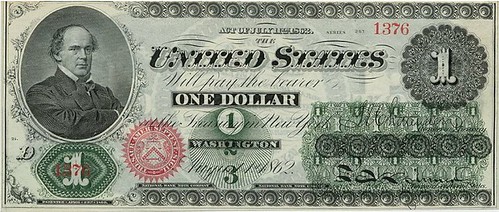
For a type set of regular currency, perhaps a single representative note such as a Legal Tender bill of 1862 would suffice. Beyond that, there are many possibilities, some very expensive, including various interest-paying series, Gold Certificates, and National Bank notes. Add to this one or several notes issued by state-chartered banks from 1861 to 1865, most bearing dates from 1861 to 1863. There are hundreds of different varieties, and most are inexpensive.
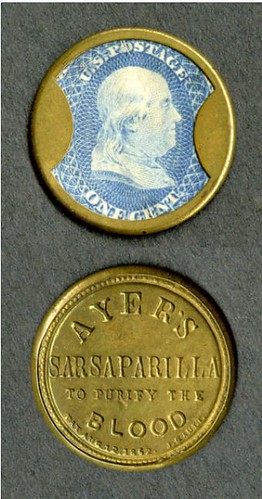
Encased postage stamps were issued beginning in the summer of 1862 by over 30 merchants. These consist of a brass frame with mica front, under which a regular postage stamp of a value from one cent to 90 cents was placed. These circulated at the value of the stamp and are widely collected today. A representative inexpensive issue would fill the bill. Lord & Taylor is the only token-issuing merchant that is still in business today in 2018.
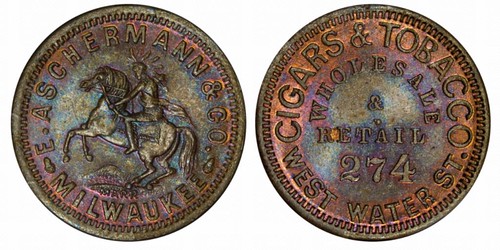
Tokens: These are in two main classes. Civil War tokens were issued by private interests and have patriotic motifs as well as merchants' advertisements. A set could include one example in each category. These are very inexpensive, and in grades such as Extremely Fine to lower Mint State, ranges can cost less than $100 each. A bit scarcer as a class are sutler tokens, issued by merchants who had licenses to travel with military troops and to operate stores selling clothing, games, books, and other items. These generally range into low three figures. In practice, most collectors of Civil War items are specialists. Those who collect Civil War store cards issued by nearly 1,000 different merchants are not likely to collect gold coins from the Civil War, and those collecting National Bank notes are not likely to collect encased postage.
The entire field is interesting and is worth investigating. Money and history come together very nicely.
To read the complete article, see:
Bowers on collecting: Civil War money
(http://mintnewsblog.com/bowers-on-collecting-civil-war-money/)
CNG AUCTION 109 CLOSES SEPTEMBER 18, 2018
Kerry Wetterstrom of CNG forwarded this press release for the firm's upcoming Auction 109. Thanks! Great coins. -Editor
An Internet and Mail Bid Sal
Closing Electronically on Wednesday, 12 September 2018
Classical Numismatic Group is proud to present CNG 109, an Internet and Mail Bid Sale closing electronically on Wednesday, 12 September 2018, from 10 AM ET (U.S.). This sale offers 1094 lots with a presale estimate of $2 million.
Our annual fall sale features Greek, Celtic, Oriental Greek, Central Asian, Roman Provincial, Roman Republican, and Roman Imperial coinage. Additionally, there are featured selections of Coin Dies and Counterfeiting Implements, Byzantine, Early Medieval, Islamic, World, United States, and British coinage.
CNG 109 is highlighted by a number of collections and individual rarities, which make up the majority of coins on offer:
• Diverse Selections from the Gasvoda, Rosenberg, and WRG Collections
• Iconic Herakles Stater from Stymphalos
• Kroisos Prototype Gold Stater
• The MNL Collection of Seleukid Coinage, Part 2
• Jewish War Year 1 Prototype Shekel
• Three Rare & Important Dinars of the Kidara Shahis
• The New Orleans Collection of Alexandrian Coinage
• A Diverse Selection of Roman Gold Coins, including a Pedigreed IMPER RECEPT Aureus of Claudius
• Roman Tesserae and Spintria from the Gasvoda Collection
• Extremely Rare TR P XVIII Medallion of Commodus
• British Medals from the Gasvoda Collection
Catalogs for CNG 109 have been mailed to our active mailing list and bidding is open on the site. Some of the individual highlights from CNG 109 are:
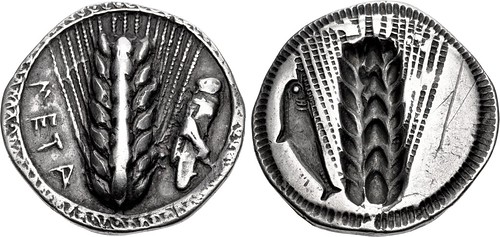
Lot 8—LUCANIA, Metapontion. Circa 540-510 BC. AR Nomos (27mm, 7.85 g, 12h). Ear of barley with seven grains; META down left field, grasshopper upward to right / Incuse ear of barley with seven grains; incuse dolphin upward to left. Noe Class V, 104 (same obv. die); Gorini 11 (this coin illustrated, enlarged on p. 137); HN Italy 1472; SNG ANS 207 = Jameson 259 (same obv. die); Gulbenkian 58 = Locker-Lampson 18 (same obv. die); Traité I pl. LXVI, 9 (same obv. die). Good VF, deep cabinet tone, a few scratches, minor die break on obverse. Very rare. Estimated at $5,00
From the Gasvoda Collection. Ex M. L. Collection of Coins of Magna Graecia and Sicily (Numismatica Ars Classica 82, 20 May 2015), lot 12; A. D. Moretti Collection; Classical Numismatic Group 40 (with Numismatica Ars Classica, 4 December 1996), lot 613; Münzen und Medaillen AG XIII (17 June 1954), lot 998.
From the consignor: The most interesting type of the incuse coinage of Metapontum certainly must be the issues which have the locust (or grasshopper) design detail, as here. There are a number of varieties with the locust/grasshopper detail. Here it is paired with a well-detailed incuse dolphin. The locust would have been a serious threat to the agricultural community and likely the dolphin relates to Apollo who would have been seen as the God who eliminated a plague of these insects in the year this coin was struck. Exceedingly rare with only two examples in CoinArchives.
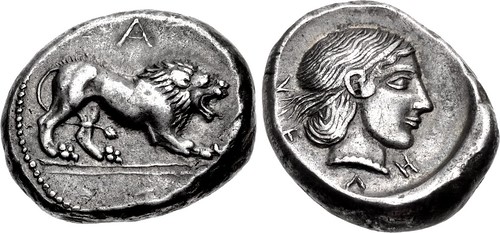
Lot 33—LUCANIA, Velia. Circa 465-440 BC. AR Nomos (19mm, 8.00 g, 5h). Lion at bay right on double exergue line; A above / Head of the nymph Hyele right; V-E-Λ-H around; all within incuse circle. Williams 71a (O54/R50) = C. Kraay, "A mid-fifth century hoard from South Italy" in SNR 66 (1987), p. 29, 1 (this coin); HN Italy 1264. EF, toned. Fine style. Rare. Estimated at $10,000
Ex Leu 81 (16 May 2001), lot 29; Leu 48 (10 May 1989), lot 25; Leu 2 (25 April 1972), lot 46; 1971 — S. Giovanni Ionico' Hoard (CH IX, 599).

Lot 38—BRUTTIUM, Kroton Circa 530-500 BC. AR Nomos (27.5mm, 7.83 g, 12h). Spread incuse type. Tripod, legs surmounted by wreaths and terminating in lion's feet, two serpents rising from the bowl, set on basis of three lines, the center dotted; (koppa)PO to left / Incuse tripod as obverse, but wreaths and serpents in relief. Gorini 4; Attianese 1; HN Italy 2075; SNG ANS 232; SNG Lloyd 592; Bement 272; Dewing 492—3; Jameson 1879; de Luynes 701; Washburn King 19 (this coin). EF, lovely old cabinet tone, minor mark in field on obverse. Well centered and struck. Estimated at $7,500
From the Gasvoda Collection. Ex CNG Inventory 955015 (June 2013); Leu 83 (6 May 2002), lot 34; Classical Numismatic Group 42 (29 May 1997), lot 83; Elisabeth Washburn King Collection, gifted to Bryn Mawr College, 1951 (Christie's, 11 December 1992), lot 619.
From the consignor: This is an important example to try to untangle the mystery of how these incuse die pairs were created. The die pair seen here was clearly intended to be mated together — notice the top of the tripod being proportionally out of level as an exact obverse/reverse match. Yet the reverse (incuse) die has the tripod slightly larger than the raised obverse. This flaw in compatibility surely caused the dies to wear too quickly as they competed with each other during striking. Were these dies created by hubbing a completed (obverse or reverse die) into a die blank to create the die mate? It seems the only logical explanation.
The Elisabeth Washburn King Collection was made up of 141 Greek coins at the time of her donation to Bryn Mawr College, the collector's alma mater, in 1951. Though modest in size, the quality of the collection was outstanding, featuring excellent examples of many of the most sought out Greek types. The collection was published in its entirety by noted art historian and future curator of classical antiquities at the Boston Museum of Fine Arts, C. C. Vermeule, in 1956, while still a professor at Bryn Mawr.
Houghton Collection, and the Susiana Find
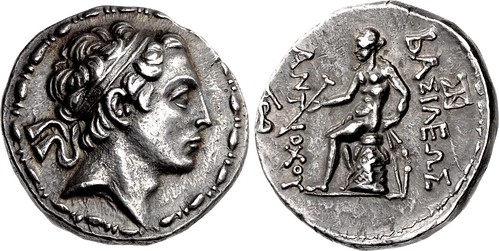
Lot 289—SELEUKID EMPIRE. Antiochos IV Epiphanes 175-164 BC. AR Tetradrachm (27mm, 17.08 g, 12h). Antioch in Persis mint. Diademed head right / BAΣIΛEΩΣ ANTIOXOY, Apollo Delphios, nude, seated left on omphalos, testing arrow in his right hand, left hand on bow, with three pellets on handle, set on ground to right; AB monogram to outer left, monogram in exergue. SC 1526.4a (this coin referenced and illustrated); CSE 1063 = P. Strauss, "Un trésor de monnaies hellénistiques trouvé près de Suse (2e partie)" in RN 1971, 29 (this coin); HGC 9, 615l. Choice EF, toned. Impressive high relief portrait. Very rare. Estimated at $5,000
From the MNL Collection. Ex Nomos 6 (8 May 2012), lot 106;— Outstanding Collection' (Leu 81, 16 May 2001), lot 335; Numismatic Fine Arts XXXI (18 March 1993), lot 333; Arthur Houghton Collection; Münzen und Medaillen AG 37 (5 December 1968), lot 241; Susiana, 1965(?) Hoard (IGCH 1806).
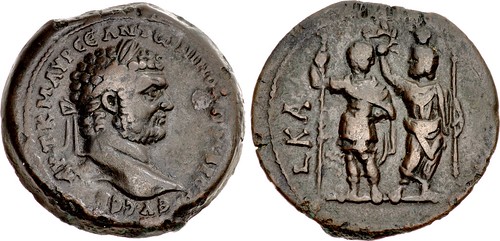
Lot 493—EGYPT, Alexandria. Caracalla AD 198-217. Æ Drachm (33.8mm, 26.37 g, 12h). Dated RY 21 (AD 212/213). Laureate head right / Caracalla, laureate and wearing military attire, standing facing, head right, holding a spear with his right hand and a globe(?) in his left; on his right, Sarapis standing facing, head left, holding a scepter with his left hand and crowning Caracalla with a wreath held in his right; L KA (date) to left. Köln 2284 var. (position of date); Dattari (Savio) 4053 & 9760 (this coin); K&G 51.16; Emmett 2831A.21 (R3). Nice VF, dark brown patina with traces of green, small spot of hard encrustation before nose, otherwise choice surfaces. Very rare, with only one other specimen sold at auction since 2000 (the Staffieri coin in Triton XXI). Estimated at $3,000
From the New Orleans Collection. Ex Triton VI (14 January 2003), lot 603; Giovanni Dattari Collection, no. 9760.
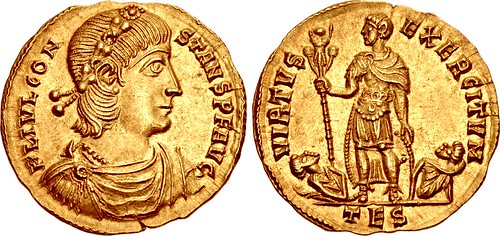
Lot 720—Constans. AD 337-350. AV Solidus (22mm, 4.61 g, 6h). Thessalonica mint. Struck AD 337-340. FL IVL CON STANS P F AVG, laurel-and-rosette-diademed, draped, and cuirassed bust right / VIRTVS EXERCITVM, Constans standing facing, head left, wearing military attire, holding a trophy mounted on a spear with his right hand and a shield on the ground with his left; a captive seated to either side at his feet, the one on the left with his hands bound, and the one on his right holding his head with his left hand, both are looking upward at the emperor; TES. RIC VIII 34; Depeyrot 4/7; DOC —; Biaggi 2126. Superb EF, small hairline flan crack, traces of underlying luster. An exceptional example. Estimated at $5,000
From the George La Borde Collection (not in the NAC sales).
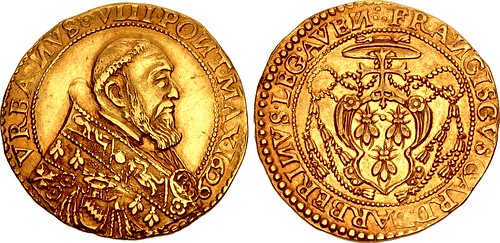
Lot 831—ITALY, Papale (Stato pontificio). Urban VIII 1623-1644. AV Quadrupla (30mm, 13.01 g, 8h). Avignon mint. Dated 1629. Bust right, wearing mantum; below, coat-of-arms surmounted by gallero with tassels / Coat-of-arms surmounted by cross fourchée and gallero with tassels. Muntoni 199; Berman 1782; Duplessy, Féodales 1974; Poey d'Avant —; Friedberg 59. Good VF, toned, lustrous. Very rare. Estimated at $7,500
Ex— Importante serie di monete d'oro dello Stato Pontificio' (Numismatica Ars Classica 104, 16 December 2017), lot 549.
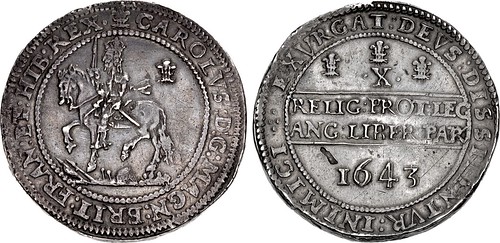
Lot 931—STUART. Charles I. 1625-1649. AR Half Pound (33mm, 59.88 g, 5h). Declaration type. Oxford mint; im: plume (with bands). Dated 1643. (plume) CAROLVS : D : G : MAGN : BRIT : FRAN : ET : HIB : REX ·, Charles, holding reins with left hand and sword in right, on horseback left, trampling arms below; plume to right / EXVRGAT : DEVS : DISSIPENTVR : INIMICI ·:·, RELIG : PROT : LEG/ANG : LIBER : PAR' in two lines between parallel lines; three plumes and " X " (mark of value) above, 1643 below. Morrieson, Oxford A/1 (same dies as illustration); Brooker Appendix I, 15 (same dies); North 2404; SCBC 2945A. Good VF, toned, small flan flaw on reverse. Excellent metal and strike. An outstanding example. Estimated at $6,000
Ex Clearwater Collection (Classical Numismatic Group Electronic Auction 312, 9 October 2013), lot 36; Marshall Collection (Spink 167, 31 March 2004), lot 131; Spink Numismatic Circular L.11 (November 1942), no. 16831.
Ex Brodie and Dundee Collections
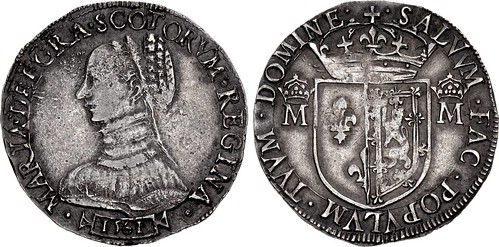
Lot 1023—SCOTLAND. Mary. 1542-1567. AR Testoon (29mm, 6.07 g, 2h). Third period, First widowhood. Edinburgh mint. Dated 1561. · MARIA · DEI · GRA · SCOTORVM · REGINA ·, bust left; date in tabula ansata below / · SALVVM · FAC · POPVLVM · TVVM · DOMINE ·, crowned coat-of-arms; crowned Ms flanking. Burns 4 and fig. 897; SCBC 5422. VF, deeply toned, some light die rust on obverse. Struck on a broad flan. Very rare and iconic type. Estimated at $7,500
From the Dr. William E. Triest Collection. Ex Spink Numismatic Circular CXI.I (February 2003), no. SH0113; Norman Brodie Collection (Dix, Noonan, Webb, 8 October 2002), lot 58; Dundee Collection (Spink/Bowers & Ruddy, 19 February 1976), lot 203.
STACK'S BOWERS AUGUST 2018 AUCTION SELECTIONS
Here are several lots that caught my eye in the upcoming Stack's Bowers ANA World's Fair of Money sales. -Editor
1781 Daniel Morgan at Cowpens Splashers

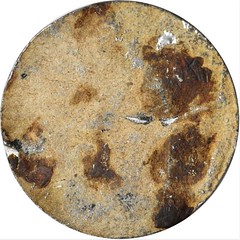
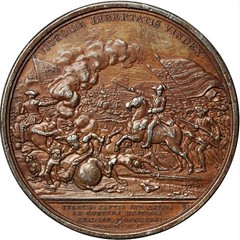
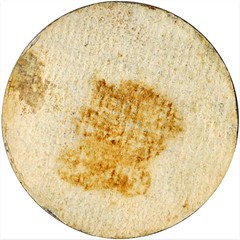
1781 Daniel Morgan at Cowpens Obverse and Reverse Splashers. Uniface. White Metal Backed With Paper. 56.4 mm. 22.56 grams and 34.30 grams, respectively. Adams and Bentley-10, Betts-593, Julian MI-7. Mint State.
The medal awarded to Daniel Morgan for his rout of the British at Cowpens is a tour de force in the Comitia Americana series, its fabulous Dupre designs and die work considered to be his second best after only the ever popular and beautiful Libertas Americana medal. The intricate reverse (actually intended as the obverse) shows a mounted Daniel Morgan leading the cavalry charge that helped defeat the better trained and similarly sized British force under Lieutenant-Colonel Banastre Tarleton at the Cowpens in South Carolina.
Dupre's scene of horses, troops, bodies, smoke, flags and carnage is unmatched in the Comitia series; the design of displayed eagle on the Americans' standard on this medal produced in 1789 presages Dupre's design of the 1790 Diplomatic Medal. Although traditionally offered as individual objects, the current set is being offered as a beautiful pair of epreuves of the completed obverse and reverse designs, created by impressing the dies into molten metal poured onto scrap paper, the remains of which are still visible on the blank backs of both pieces. Remains of wax or epoxy or also on the backs of both, as they were perhaps mounted to a display at some juncture in their 230 year existence.
The obverse splasher, or cliché, is notably thinner, its surfaces a pleasing medium gray with natural lacuna from thin tin, chiefly below the exergual line where the pour must have been thinnest. This delicate object is quite straight, though with slight waves through MORGAN and through the periphery around the 5 o'clock position. Its back shows some of the bright metal where the paper backing has been scraped away. The reverse splasher, or cliché, is notably thicker than the obverse, with a coating of protective lacquer on its face that gives the initial impression of a bronze specimen. Light handling marks are noted chiefly along the rims, and some lacuna in the metal are noted around the 3 o'clock position.
Amazing artifacts from the classic series of medals commemorating events of the American Revolution. -Editor
To read the complete lot description, see:
1781 Daniel Morgan at Cowpens Obverse and Reverse Splashers. Uniface. White Metal Backed With Paper.
(https://auctions.stacksbowers.com/lots/view/3-BJAW9)
1865 New York State Volunteers Medal
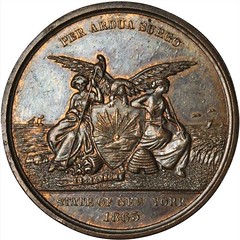

1865 New York State Volunteers Medal. Bronzed Copper. 37.4 mm. Julian MI-32, Vernon US-475. About Uncirculated.
Struck to be presented to volunteers from New York who served in the Army or Navy during the Civil War, this one not inscribed with a recipient's name. An important medal in that R. W. Julian in his encyclopedic Medals of the United States Mint described this previously unknown medal from only fragmentary information in Mint records. He could only note the size and that the obverse was dated 1865 and the reverse inscription began with PRESENTED TO. Here is the complete description. Obv: An eagle surmounted Seal of the State of New York with PER ARDUA SURGO above, STATE OF NEW YORK / 1865 below. Rev: A 14-line inscription PRESENTED TO / (blank) / BY R. E. FENTON, / GOVERNOR / OF THE STATE OF NEW YORK. / IN PERSUANCE OF / CONCURRENT RESOLUTIONS / OF THE / LEGISLATURE, / AS A MEMENTO / OF THE / COURAGE AND FIDELITY / WITH WHICH HE HAS SERVED / THE STATE, / DURING THE WAR OF THE REBELLION.
Choice semi-reflective surfaces still displaying some of the original mint red. The planchet and surfaces with no problems of note. An interesting consideration is that this medal is valued at $1,000 in Sidney B. Vernon's Collectors Guide to Orders, Medals and Decorations, Fourth Revised Edition (2000), the latest edition, although still 18 years old as of this writing.
To read the complete lot description, see:
1865 New York State Volunteers Medal (https://auctions.stacksbowers.com/lots/view/3-BJC8U)
1871 George F. Robinson Medal


1871 George F. Robinson Medal. Silver. 76.8 mm. 3,613.5 grains. By Anthony C. Paquet. Julian PE-27. MS-63 (NGC).
Witness line at 8:45. Both the obverse and reverse of this piece are a beautiful silver gray with iridescent gold overtones and a few areas of blue and rose, principally around the peripheries. The centers are very sharply struck and the dramatic rescue scene on the reverse is bold and clear. The rims are undamaged and the edge is sound. Extremely rare: one of just two struck in silver sometime between 1874 and the first half of 1875. This medal was voted by Congress in gold for Robinson's preventing the assassination of Secretary of State William Seward at the hazard of his own life. Robinson's gold medal was received by the Smithsonian in 1947.
To read the complete lot description, see:
1871 George F. Robinson Medal (https://auctions.stacksbowers.com/lots/view/3-BJEF7)
So what's a "witness line"? Dick Johnson's dictionary doesn't include this term. A search of the Newman Numismatic Portal reveals many instances of it. One definition is a "collaring mark from a bipartite collar".
A 1979 (Vol. XLIX) British Numismatic Journal article by Marvin Lessen on the Cromwell Lord General Medal by Simon notes, "The edge of most specimens shows distinct witness-line traces of the steel band used in conjunction with a surrounding collar during striking..." -Editor
I reached out to Dick Johnson, who writes:
This is what Americans call "Collar Gap" which is a far more descriptive term.
Collar Gap. The space between the segments of a segmented collar and the resulting line on the edge of a coin or medal struck from such a collar.
The line runs across the edge (perpendicular to the obverse and reverse), and sometimes all three lines may be present — proving it was struck from a trisegmented collar.
These lines will be equidistant from each other. Collar gaps are found on some U.S. Mint medals of the 19th century.
CLASS 06.6
Below is text from Roger Burdette's From Mine to Mint, which incorporates another usage. (Thanks, Roger!) -Editor
Infiltration — This was the process of filling the crack or other defect with hard material such as steel wire. The infiltration could be locked in place by mechanical means, such as undercutting and packing, or by welding the filler in place. In either event, considerable surface smoothing had to occur. This was difficult to apply to small cracks and would usually not withstand significant heat treatment. Even after successful post repair machining has been completed, a "witness line" which resembles shrinkage lines can be noted between the repair and the adjacent die steel. This can, if excessive pressure is used, result in a die crack propagating from the witness line to a weak point in the die.
It's the line or junction between a repair and adjacent steel or at the junction of two pieces of metal. It comes from the idea that the "line is a witness" to the repair.
"1861" (1891) State of Pennsylvania First Defenders Medal of Honor Obverse Struck on an 1861 Liberty Head Double Eagle
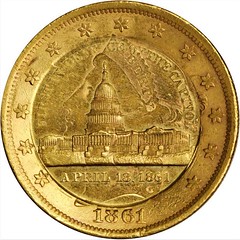
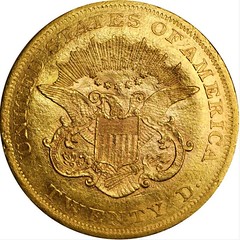
Impressive Pennsylvania First Defender's Medal Obverse Struck over an 1861 Double Eagle
"1861" (1891) State of Pennsylvania First Defenders Medal of Honor Obverse Struck on an 1861 Liberty Head Double Eagle. 34.9 mm. 33.4 grams. Mint State.
On April 15, 1861 President Abraham Lincoln put out a request for volunteer soldiers to participate in the battle against the Southern secessionists. Thousands quickly responded to this request, but the first group to reach Washington was composed of some 500 Pennsylvanians of the Ringgold Light Artillery of Reading, the Logan Rifles of Lewistown, the Allen Infantry of Allentown, and the National Light Infantry and Washington, both of Pottsville, all of whom arrived in Washington - not without difficulties - three days later during the evening of April 18, 1861. Celebrated at the time for their quick response, these volunteers were to continue to receive accolades long after the Civil War had ended.
Thirty years later, on May 26, 1891, the Pennsylvania State Legislature proposed another honor for the First Defenders, and an appropriation for "Medals of Honor" for the First Defenders be made. As quoted from the proposition,
"Be it Enacted, That the sum of one thousand five hundred dollars, or so much thereof as may be necessary, is hereby specifically appropriated for the purpose of procuring a suitable medal with commemorative devices, for each of the surviving members or their heirs, of the National Light Infantry of Pottsville, Pennsylvania; the Washington Artillerists of Pottsville, Pennsylvania; the Reading [Ringgold] Artillery, of Reading, Pennsylvania; the Allen Infantry, of Allentown, Pennsylvania; and the Logan Guards of Lewistown, Mifflin County, Pennsylvania, to commemorate the event of the said five companies being the first to respond to the call for troops by President Lincoln, of date April 15th, one thousand eight hundred and sixty-one, mustered in at Harrisburg, Pennsylvania, on the 18th day of April one thousand eight hundred and sixty-one, and reached Washington, District of Columbia, and were stationed in the Capitol building for its defense on the 18th day of April, one thousand eight hundred and sixty-one."
Quickly approved by the State Legislature, the medals were soon designed and struck. The original medals were a complicated affair composed of a 24 mm bronze medal inserted into a 38 mm radiant Greek cross. The cross was suspended by a loop at the top from a red, white, and blue silk ribbon - which in turn was attached to a bronze pin-back hanger embellished with the Pennsylvania State Seal and the words FIRST / DEFENDER to the left and right. Long regarded as one of the most desirable of Civil War medals, this original award is rarely seen today.
The present piece is a regular issue 1861 Liberty Head double eagle with the obverse of the central medallion of the First Defenders cross stamped onto its face. It features a view of the United States Capitol Building (as it appeared in the late 1800's) with the inscription FIRST IN DEFENCE (sic) OF THE CAPITOL above, and APRIL 18, 1861 below. Many times rarer than the original medal - of which it is thought that only 127 of the possible 475 First Defenders (or their heirs) actually received - this piece is very likely a one-of-a-kind example.
The stamping is nicely centered, with the 1861 date of the original coin quite clear, and a shadowy image of the original Liberty Head still detectable in the fields. The reverse of the original coin is completely visible, although flattened a bit in the center, opposite the medal stamping. The host coin is nearly a full millimeter larger than a normal Liberty $20, a result of the stamping of the medal design.
Another of the many wonders of numismatics. Just when you think you've already seen eveything, something like this comes along. If only we knew more about its history - when was it struck, and for whom? -Editor
To read the complete lot description, see:
"1861" (1891) State of Pennsylvania First Defenders Medal of Honor Obverse Struck on an 1861 Liberty Head
Double Eagle (https://auctions.stacksbowers.com/lots/view/3-BJDIP)
1859 Indian Cent
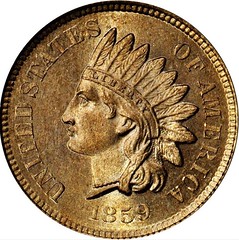
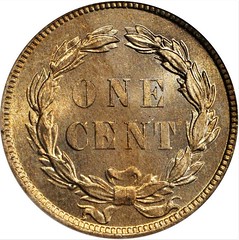
1859 Indian Cent. MS-66 (PCGS). CAC.
James Barton Longacre's widely collected Indian cent made its debut in 1859 with a mintage of 36,400,000 circulation strikes and approximately 800 Proofs. The obverse portrait, in fact, is not that of a Native American but rather a representation of Liberty wearing a feathered headdress. The artist's original concept for this design made its debut in 1849 on the gold dollar, and subsequently went through various refinements (including on the three-dollar gold piece first issued in 1854) before appearing on the Indian cent.
The reverse of the 1859 cent exhibits a simple olive wreath without a shield at its top, a design that was abandoned in 1860 in favor of the Oak Wreath with Shield design. (The olive wreath has gone down in numismatic literature as a laurel wreath due to Mint Director James Ross Snowden's designation from 1860.)
The 1859 Indian cent, therefore, is a one year design type that is eagerly sought by today's collectors. Fortunately, many 1859 Indian cents have survived in Mint State, yet on the other hand most are poorly defined due to the Mint's widespread use of worn dies in production of this issue.
A beautiful example. -Editor
To read the complete lot description, see:
1859 Indian Cent (https://auctions.stacksbowers.com/lots/view/3-BJBUV)
1955 Doubled Die Obverse Lincoln Cent
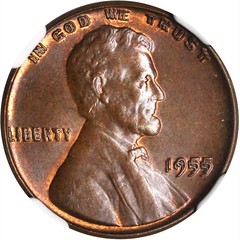
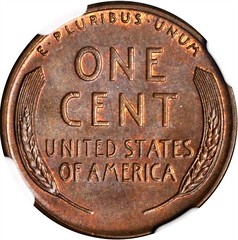
1955 Lincoln Cent. FS-101. Doubled Die Obverse. MS-65 BN (NGC). CAC.
The story of the 1955 Doubled Die Obverse Lincoln cent was first told in detail by our own Q. David Bowers in 1964 in his first book, Coins and Collectors, but is worth repeating in summary here:
In 1955 Jim Ruddy (who in 1958 became Dave's partner in the Empire Coin Company in Johnson City, New York), was shown a Lincoln cent with curiously doubled letters and numbers on the obverse. He found it interesting, and bought it for 25 cents. This attracted the attention of a newspaper writer who interviewed Jim, and he said he would pay a quarter each for all offered. After a couple dozen came in he rescinded his offer.
It turns out that nearly all were found in cigarette packs. The price of a pack in a vending machine was 23 cents at the time. Anyone inserting a quarter would get a pack of cigarettes with two bright Lincoln cents under the cellophane on one side. At that time there was very little interest in mint error and die error coins. That did not happen until some years later when Frank Spadone, a New Jersey dealer, published a booklet on the subject and, also a bit later, Michael Kolman, Jr., of the Federal Coin Exchange in Cleveland, advertised and displayed struck mint errors (as opposed to error dies).
Now in 2018 interest is intense in such fascinating die varieties, mainly propelled by the standard work on the series, Cherrypicker's Guide to Rare Die Varieties by Bill Fivaz and J.T. Stanton. Dave contacted the Philadelphia Mint and spoke with the person who was involved. It turned out that on one particular day multiple presses were striking 1955 Doubled Die cents. Someone examining a bin in which the output for the presses had been dumped noticed a "freak" coin with blurred lettering. The press was identified and the offending die replaced. By that time the press had struck 40,000 pieces, 24,000 of which had been mixed with other coins and were sent out for regular distribution, there being no particular reason to save them. The others, still in a bin at the press, were destroyed. Thus, the net production amounted to about 24,000 pieces. In time, we believe in about a year, the variety was published, called the 1955 "Shift cent" by some. It was not until a few years later that it was listed in A Guide Book of United States Coins, at which time Ken Bressett assigned the designation Doubled Die, which has since been applied to many varieties in other series. The coins caught on, became worth several dollars, and then even more.
A classic U.S. variety, always popular yet available in the marketplace due to the relatively large population. -Editor
To read the complete lot description, see:
1955 Lincoln Cent (https://auctions.stacksbowers.com/lots/view/3-BJ9VZ)
1796 Draped Bust Cent Struck 65% Off Center, Cut Down and Overstruck

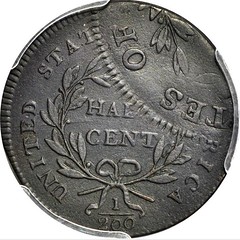
Extremely Rare and Famous 1796 NC-7 Draped Bust Cent Overstruck by a 1797 C-3b Half Cent
Just Two in Private Hands
1796 Draped Bust Cent--Struck 65% Off Center, Cut Down and Overstruck by 1797 C-3b Half Cent Dies--NC-7. Rarity-8. EF Details--Environmental Damage (PCGS).
This famous rarity has been the object of considerable debate among early copper enthusiasts regarding the order of striking, i.e. whether the initial impression came from the half cent or cent dies. PCGS has certified this coin as a 1797 C-3b half cent (coin #35113), the insert stating: "O/S by 1796 NC-7." Since its discovery in 1994, however, the general consensus has been that this coin started as a 1796 Draped Bust cent that as struck 65% off center, the planchet subsequently cut down and overstruck by 1797 C-3b half cent dies. Indeed, this is how John Whitney Walter collected this coin, and it is how it is listed in the census of known examples in Walter Breen's Encyclopedia of Early United States Cents: 1793-1814 (2000) and on the PCGS CoinFacts website. This coin has also been cataloged as a 1796 NC-7 Draped Bust cent in our (Bowers and Merena's) Herman Halpern Collection sale of March 1995, and in our (Stack's) subsequent offering of the John Whitney Walter Collection of Coins of 1796 (May 1999).
Here's the census of the three known examples. -Editor
1- PCGS EF Details--Environmental Damage. Ex our (Bowers and Merena's) Herman Halpern Collection sale, March 1995, lot 2307; our (Stack's) sale of the John Whitney Walter Collection of the Coins of 1796, May 1999, lot 1758. The present example, unattributed when consigned to Bowers and Merena in October 1994, the attribution determined by March Borckardt and confirmed by Denis Loring and Dr. John Kleeberg.
2 - EAC Good-6. John P. Kennedy; George H. Clapp, March 1928, discovered in the Kennedy Collection and described by Clapp in The Numismatist, Vol. XLI, 1928, p. 315; B. Max Mehl, privately; "Colonel" E.H.R. Green; Burdette G. Johnson (St. Louis Stamp & Coin Co.), April 1946; George H. Clapp; ANS Collection.
3 - EAC AG-3. Purchased attributed by Rod Burress, 1999; Daniel W. Holmes. Jr., 1999.In summary, this is one of just two collectable examples of this Rarity-8 1796 NC-7, a coin that combines both great rarity and importance for numismatic history. There is some disagreement in the copper community over how this coin was actually struck. Many believe that the 1796 NC-7 cent came first and that the 1797 half cent is struck over the cent, as described here. Others believe that the large cent is struck over the half cent. Simply looking at the coin, even under high magnification, does not completely answer the question of which came first, the half cent or the cent. For example, Breen noted that it was not possible to figure out whether the 1796 S-115 cent or the 1797 half cent came first on the piece Frank Stewart found when his men demolished the first mint building site (published 1916 in The Numismatist).
Luckily for numismatics, Ron Landis of the Gallery Mint Museum consented to try an experiment. With the present coin before him as a guide, and using dies of his own making, Ron struck sample coins both ways. First, he struck 1796 large cent dies off center onto a planchet, then cut the off center struck large cent down to half cent planchet size. He then lettered the edge with a half cent legend, and then used the off center strike as a planchet for his 1797 half cent dies. Next, he struck a centered, edge lettered 1797 half cent and then using that coin as a planchet struck it off center with the 1796 large cent dies he had made. Finally, Ron placed one each of his sample coins alongside this NC-7 and compared them. There was no question any more as to which came first. The large cent was seen to have been struck first, off center, and this "spoiled cent'' (as Breen called them) was used as a planchet for the 1797 half cent.
This coin presented a fascinating technical puzzle (or was it riddle, wrapped in a mystery, inside an enigma)? This is what makes error coin collecting so interesting - it's a crash course in the coin manufacturing process, and I would say you can't call yourself a true numismatist without a solid understanding our how these objects are made.
Would anyone have any images of the examples Ron Landis made for this study? -Editor
To read the complete lot description, see:
1796 Draped Bust Cent--Struck 65% Off Center, Cut Down and Overstruck
(https://auctions.stacksbowers.com/lots/view/3-BIQPQ)
1943 Lincoln Cent Overstruck on a 1943 Mercury Dime

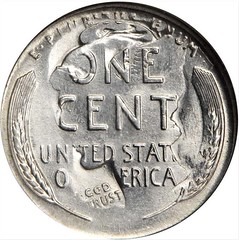
Remarkable 1943 Lincoln Cent Overstruck on a 1943 Mercury Dime
Ranked No. 39 of the 100 Greatest U.S. Error Coins
1943 Lincoln Cent--Overstruck on a 1943 Mercury Dime--MS-62 (NGC).
This intriguing and rare double denomination error is ranked No. 39 in the popular reference 100 Greatest U.S. Error Coins by Nicholas P. Brown, David J. Camire and Fred Weinberg, where it is described as: "A breathtaking coin to see, this double denomination combines the popularity of not only the Lincoln cent and the Mercury dime, but also the 1943 date (caused by the desirability of the famous 1943 copper cents....). This example, like other wrong-planchet, off-metal strikes, resulted from overlooked coins being left in tote bins. From there it was a simple matter for this dime to be mistakenly fed into a press coining cents.
"This nice brilliant Uncirculated specimen is one of two known for this date and series, and it shows excellent details of the original dime impression. In this case, the obverse cent design is on the reverse of the dime, and vice versa. This was entirely a random matter, and it just as easily could have been coined in the other orientation.
"As has been previously noted, off-metal error coins are very popular. The 1943 error coinage carries special collector interest due to the publicity surrounding the 1943 bronze cent. There are not many 1943 cents struck on dimes. In high grades they always command a premium."
To this excellent write up we would add very little other than to report that the other known example of a 1943 cent overstruck on a 1943 dime appeared in our (Bowers and Ruddy's) Terrell Collection sale of May 1973, lot 1092. For that coin, the obverse and reverse of both types were aligned. On the present example, portions of all four digits in the date for the Mercury dime are discernible within the lower portion of the right wheat ear. Special thanks to Saul Teichman for providing us with census and provenance information relating to this significant Mint error.
Another fabulous error coin. Who wouldn't want to have this one? -Editor
To read the complete lot description, see:
1943 Lincoln Cent--Overstruck on a 1943 Mercury Dime (https://auctions.stacksbowers.com/lots/view/3-BINUG)
FRANK VITTOR'S PITTSBURGH VENUS
Pittsburgh sculptor Frank Vittor designed the 1936 Gettysburg Half-Dollar. Several years ago I wrote and article about him that led to a change in A Guide Book of United States Coins, which had mistakenly described Vittor as a "Philadelphia sculptor".
Vittor himself is the only numismatic connection in the following article, but it's an interesting study in artistic expression and public opinion. See the complete article online for a great read.
Thanks to Larry Dziubek for sending this item from the Pittsburgh Post-Gazette. GREAT photo. -Editor
Larry writes:
There was an article in Sunday's P-G about Vittor doing a full size statue of a local gal who became Miss America in 1935. She was in a bathing suit but he made her nude in plaster. The bronze was never made.
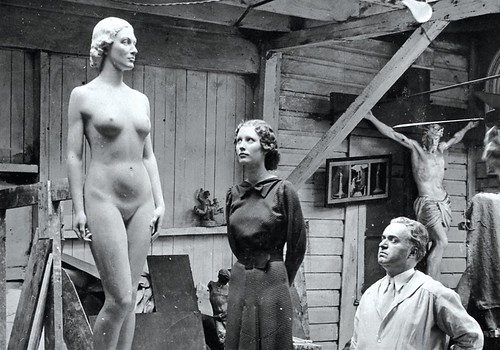
Pageant judge Walter Thornton said the young woman from the Mon Valley "represents the perfect American type." When her name was announced as the pageant's winner, she threw her arms around a nearby policeman and gasped, "I can't believe it's true." Her grandmother, who accompanied her to Atlantic City as her chaperone, proudly told the press, "I knew all along that Henrietta was the prettiest girl in Atlantic City!"
For winning, Leaver received a Hollywood screen test, a host of Vaudeville offers and a two-week cruise to Europe on the French luxury liner Normandie. Upon her triumphant return to Pittsburgh, the new Miss America was approached by Vittor, who wanted to immortalize her with a statue.
Vittor was Pittsburgh's best known artist. A student of the French master Auguste Rodin, he had sculpted the statue of Honus Wagner outside Forbes Field (later moved to PNC Park) and had decorated the piers of the new Westinghouse Bridge.
Leaver agreed to pose for Vittor. Always chaperoned by her grandmother, Leaver made a number of trips to the artist's Fifth Avenue studio to pose in her black Miss America swimsuit.
All went well until the unveiling of the plaster model that was to be used to cast the final bronze sculpture. Accompanied by her grandmother, Leaver went to Vittor's studio again to inspect the near-life-size sculpture.
According to a full-page story in the Sun-Telegraph, when the drape was removed, Leaver gasped, "Why, I'm all naked!" To which Vittor replied, "Yes, of course."
"But I wore a bathing suit when I posed for you," the embarrassed woman protested.
In a misguided attempt to calm his increasingly irate model, Vittor replied, "I can assure you it is as true to life as if you hadn't."
Leaver stamped her feet and demanded, "You put a bathing suit on that statue before you exhibit it."
Vittor reportedly rejoined: "A bathing suit on a Venus! This is not merely a portrait of you or even of Miss America. It is the Pittsburgh Venus ... the perfect American figure. ... No Venus will ever wear a bathing suit!"
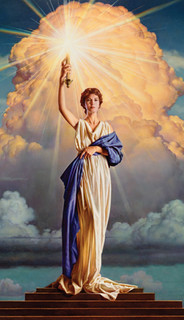 Leaver moved to Hollywood, took acting
classes and was given a bit part in the musical "Star Struck." Her dreams of stardom never materialized, but she may have achieved some measure of Hollywood
immortality.
Leaver moved to Hollywood, took acting
classes and was given a bit part in the musical "Star Struck." Her dreams of stardom never materialized, but she may have achieved some measure of Hollywood
immortality.
In the late 1930s, she received a photo release form and a check for $250 from Columbia Pictures. The torch-bearing woman that graces Columbia's logo to this day bears a remarkable resemblance to Henrietta's studio publicity shots. Though the studio refused to confirm that Leaver's photo was used for this purpose, many film historians believe she was the inspiration for the studio's logo.
To read the complete article, see:
The
Next Page: McKeesport's Henrietta Leaver remembered for more than being Miss America 1935
(http://www.post-gazette.com/opinion/Op-Ed/2018/08/05/The-Next-Page-Her-biggest-victory-Miss-America-1935-McKeesports-Henrietta-Leaver-Jim-Busch/stories/201808050007)
To read my "Frank Vittor, Pittsburgh Sculptor" article, see:
FRANK VITTOR, PITTSBURGH SCULPTOR (http://www.wpns1878.org/pr/vittor.html)
THE COINAGE OF MUGHAL EMPRESS NUR JAHAN
Arthur Shippee forwarded this New York Times book review which briefly mentions coinage of Mughal Empress Nur Jahan. -Editor
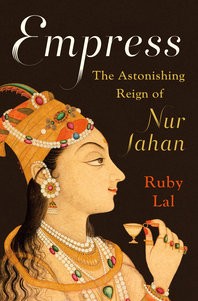 The story of
Nur Jahan, the daughter of Persian immigrants who became queen of the Mughal Empire, approaches the status of legend in South Asia. She has been the subject of comic books, a
Bollywood movie and innumerable tall tales. What has been missing is an accessible biography that explains how a woman came to amass power and influence in a patriarchal dynasty
that ruled much of what is now India, Pakistan, Afghanistan and Bangladesh.
The story of
Nur Jahan, the daughter of Persian immigrants who became queen of the Mughal Empire, approaches the status of legend in South Asia. She has been the subject of comic books, a
Bollywood movie and innumerable tall tales. What has been missing is an accessible biography that explains how a woman came to amass power and influence in a patriarchal dynasty
that ruled much of what is now India, Pakistan, Afghanistan and Bangladesh.
Ruby Lal sets out to fill in some of those gaps with "Empress: The Astonishing Reign of Nur Jahan."
Though she was just one of Jahangir's wives, she became his favorite and was often by his side as he traveled his empire. We know that she held a special position, unlike that of any other woman, because she issued royal decrees and coins were minted bearing her name, something done for sovereigns, not their wives. Her rise created tensions in the court and the royal family, which were documented by foreign envoys, who often wrote with disdain about Nur's influence over Jahangir and described him as an alcoholic. Britain's ambassador, Thomas Roe, concluded that Nur "governs him, and wynds him up at her pleasure."
Lal has done a service to readers interested in the Mughal period and the many forgotten or poorly remembered women of Indian history. She has helped shine a little light on an enigmatic character many think they know but few actually understand.
To read the complete article, see:
Mughal Men Ruled South Asia " and One Man Was Ruled by a Woman
(https://www.nytimes.com/2018/08/10/books/review/empress-nur-jahan-ruby-lal.html)
I poked around and found an example of her coinage on the site of Classical Numismatic Group. -Editor
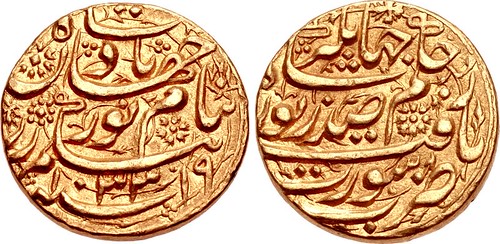
An Issue in the Name of Mughal Empress Nur Jahan
CNG 88, Lot: 1882. Estimate $3000.
Sold for $40000. This amount does not include the buyer's fee.
INDIA, Mughal Empire. Nur al-Din Muhammad Jahangir, with Begum Nur Jahan. 1605-1627. AV Mohur (20mm, 10.87 g, 3h). Surat mint. Dually-dated RY 19 and AH 1033 (AD 1623/4). Titles of Jahangir in four lines / Mint and date formula in three lines. Hull 1539 var. (date); Friedberg 782; KM 190.2 var. (unlisted date). Near EF. Rare.
To read the complete lot description, see:
An Issue in the Name of Mughal Empress Nur Jahan (https://www.cngcoins.com/Coin.aspx?CoinID=193477)
Here's a silver rupee from the World of Coins site. -Editor
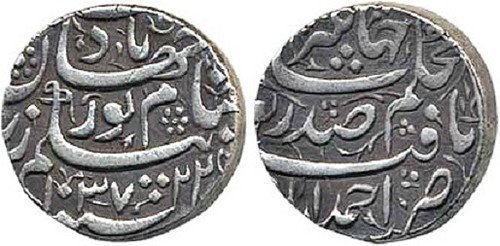
Nur Jahan, Silver Rupee, 11.18g, Ahmedabad Mint, AH 1037, RY 22
The poetic couplet on the coin reads:
Ba hukm Shah Jehangir yafta sad zevar
Ba nam-e-Noor Jehan badshah begam zer
[Coin struck] by the order of Shah Jehangir, [This] gold hath a hundred beauties gained with the inscription of the name of Noor Jehan, the Badshah Begum (Empress).
In the waning years of his reign (AH 1031/22 - 1037), Jahangir lost himself in drink, and allowed his queen Nur Jahan to effectively run the administration of the empire. This coin is tangible proof of Nur Jahan's power, as she places her own name on the coin, although nominally the issuer is Jahangir. Due to Nur Jahan's undue influence on Jahangir and her interference with Shah Jahan's accession, Shah Jahan made it a capital crime to use these coins and ordered them all melted, accounting for their rarity now. Those that escaped the melting pot were deliberately disfigured as Shah Jahan wanted to obliterate all reference to Nur Jahan and remove her name from all sources of records including coins.
This coin is dated in the last year of Jahangir's reign ie AH 1037, and RY 22, with both the dates featuring distinctively and complete on the coin, which is also devoid of disfigurement or any test-marks. Apart from Razia Sultan of the Delhi Sultanate, Nur Jahan was the only other Muslim women to feature on an Indian coin.
To read the complete article, see:
Nur Jahan: Silver Rupee of Ahmedabad Mint (http://www.worldofcoins.eu/forum/index.php?topic=22620.0)
THE ROYAL MINT'S COLLECTIVE SHIELD REVERSES
Regarding an image of British coins making the rounds on Facebook, John Mutch writes:
It took me a while to see the shield.
A look through the E-Sylum archive confirms that we've discussed this before, and it's been longer ago than I thought. Here's text from our April 6, 2008 article alongside the image. -Editor
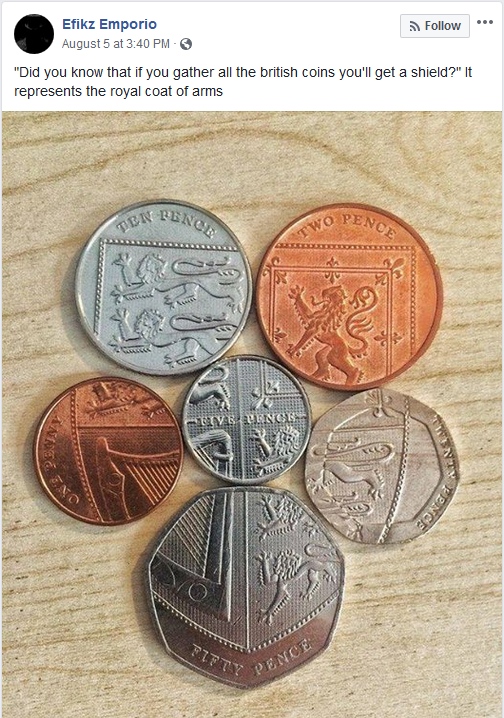 [On Wednesday Phil Mernick forwarded a copy
of the Royal Mint's press release announcing the new reverse designs for Britain's coins. He writes: "Very different!" Indeed, the new designs will likely take
some explanation and some 'getting used to'. As Dick Johnson notes below, the concept is borrowed from the medallic world, although the young designer may well have
conceived of it independently. Here is a short excerpt from the Mint's release. -Editor]
[On Wednesday Phil Mernick forwarded a copy
of the Royal Mint's press release announcing the new reverse designs for Britain's coins. He writes: "Very different!" Indeed, the new designs will likely take
some explanation and some 'getting used to'. As Dick Johnson notes below, the concept is borrowed from the medallic world, although the young designer may well have
conceived of it independently. Here is a short excerpt from the Mint's release. -Editor]
"Today, the Royal Mint is proud to unveil the new designs for the reverse of circulating coins used in the United Kingdom. It has been almost 40 years since the most current reverse designs were introduced and the new designs will renew and reinvigorate the UK's coinage.
"A different detail from the shield of the Royal Arms is shown on the reverse of the 1p, 2p, 5p, 10p, 20p and 50p coins and when placed together the coins reveal the complete shield.
"The Shield of the Royal Arms has been given a contemporary treatment and its whole has been cleverly split among all six denominations from the 1p to the 50p, with the 1 coin displaying the heraldic element in its entirety. This is the first time that a single design has been used across a range of United Kingdom coins.
"Against all the odds, a young artist has won a public competition and devised a stunningly original series that stands as an imaginative and clever solution."
To read the earlier E-Sylum article, see:
ROYAL MINT UNVEILS NEW CIRCULATING COIN REVERSE DESIGNS (http://www.coinbooks.org/esylum_v11n14a21.html)
WORCESTERSHIRE MEDAL SERVICE FOUNDER
A couple weeks ago we had an article about the Worcestershire Medal Service, a maker of British military medals. A new story this week from the Express has more information on the founder of the firm, Phil McDermott. -Editor
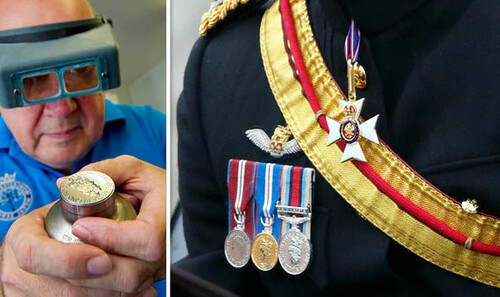
A BOY's fascination with his father's military honours was the inspiration behind the company that secured an £11million contract to make medals for the Ministry of Defence. From the age of nine, Phil McDermott played with his father Stan's medals awarded for his service in Burma during the Second World War.
As the hobby grew, wartime friends of his father handed their medals to him to be mounted and added to his collection.
His dedication continued into adulthood but he decided to sell the entire collection after the arrival of his daughter in 1988.
But a dealer was so impressed with the work that, instead of buying the lot, he asked Mr McDermott, 57, to mount his collection.
And the hobby soon turned into profession as the IT worker formed a business to manufacture and collect medals. He started with £120 of stock to form the multi-million pound Worcestershire Medal Service that last month saw off competition from the Royal Mint to make all UK military medals apart from the Victoria Cross.
Mr McDermott, of Bromsgrove, said: "It is amazing really. In those days it was a rare hobby to have. My dad served, and my uncles, in pretty much every theatre around the world. The men my father worked with had served too, and they would bring their medals in for me. I am just like a kid in a sweetshop here. I'm surrounded by what I love."
He added: "I'm still very interested in it and we do a lot of research for families now, find out the history of their medals.
"Sometimes people will come to sell their medals and then after they hear the story behind them they decide to keep them.
"I didn't really know what I wanted to do when I grew up but I certainly didn't know I could be making money from my hobby. I don't go to work a day in my life. My wife recently asked me what I wanted to do for my birthday and I said,— 'I want to go to work'."
To read the complete article, see:
Man who makes the medals for our heroes
(https://www.express.co.uk/life-style/life/999071/ministry-of-defence-million-contract-heroes-uk-military-medals)
To read the earlier E-Sylum article, see:
WORCESTERSHIRE MEDAL SERVICE WINS CONTRACT (http://www.coinbooks.org/v21/esylum_v21n30a28.html)
THE PETERLOO MASSACRE MEDAL
A museum in Manchester, England has acquired a rare medal commemorating a bloody 1819 protest. -Editor
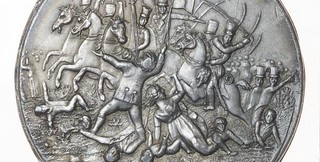 The New Peterloo Medal will be
displayed for the first time at the People's History Museum from the evening of Thursday August 9-Friday August 31.
The New Peterloo Medal will be
displayed for the first time at the People's History Museum from the evening of Thursday August 9-Friday August 31.
The Peterloo Massacre occurred on August 16,1819 when 60,000 people gathered on what was then known as St Peter's Field in Manchester, seeking the reform of parliamentary representation.
When troops charged the crowd the peaceful protest was turned into a massacre and an estimated 18 people lost their lives. It is thought the medal may have been produced to raise funds for the victims of the massacre.
While there were several commemorative medals produced following the massacre - with a different example already on display in the museum - The New Peterloo Medal is believed to be the only one of its kind uncovered to date.
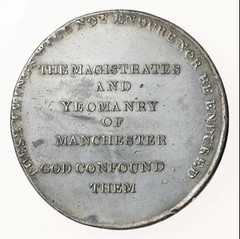 The new acquisition features a more
aggressive slogan than its counterparts. The front of the coin depicts a scene with the yeomanry riding into the crowd, one individual holding up a cap of liberty on a pole.
The new acquisition features a more
aggressive slogan than its counterparts. The front of the coin depicts a scene with the yeomanry riding into the crowd, one individual holding up a cap of liberty on a pole.
The inscription on the back reads, "The magistrates and yeomanry of Manchester God confound them", and "These things will not endure or be endured" around the edge.
Jenny Mabbott, head of collections at People's History Museum, said: "As we head towards the 200th anniversary of Peterloo and during the centenary year of the first women obtaining the vote, there couldn't be a more appropriate time to reflect upon the themes of protest and democracy which this historical event brings to the fore.
"The New Peterloo Medal is an incredibly exciting and rare addition to our existing Peterloo collection and is definitely a must see for anyone who wants a taste of what's to come at the People's History Museum in 2019."
Here's some more information on the People's History Museum from their web site. -Editor
The museum holds the largest collection of political material in Britain. Befitting the national museum of democracy, objects related to the fight for the vote make up a core of the collection. The objects are hugely varied. The PHM collection of trade union and political banners is the largest and most important of its type in the world. The museum also houses an internationally significant political archive and includes the complete holdings of the Labour Party and Communist Party of Great Britain. PHM also holds over 95,000 photographic images covering labour history, the Labour Party and more general political history
To visit the People's History Museum website, see:
https://phm.org.uk/
To read the complete article, see:
Peterloo massacre victims remembered
199 years on as People's History Museum issue rare medal
(http://www.mancunianmatters.co.uk/content/080877583-peterloo-massacre-victims-remembered-199-years-peoples-history-museum-issue-rare)
A web search found a full image of the obverse in a different article. -Editor
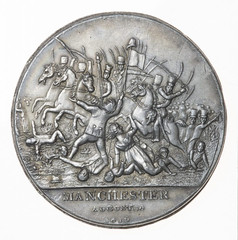

To read the complete article, see:
Rare medal goes on display to commemorate 199th anniversary of Peterloo at People's History Museum
(http://aboutmanchester.co.uk/44279-2/)
On the web site of medal dealer Timothy Millet is one with a different inscription on the reverse. The lot description discusses the origin of the name "Peterloo". -Editor
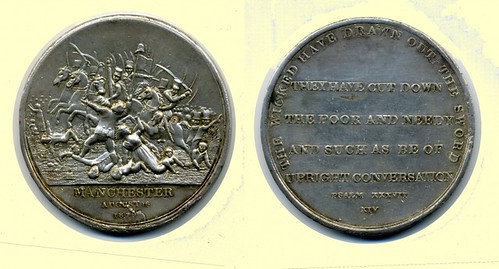
Peterloo Riots, white metal medal, circa 1819, the cavalry cut down men, women and children in the street, MANCHESTER/ AUGUST 16/ 1819, rev. MANCHESTER/ AUGUST 16/ 1819, REV. THE WICKED HAVE DRAWN OUT THE SWORD/ THEY HAVE CUT DOWN/ THE POOR AND NEEDY/ AND SUCH AS BE OF/ UPRIGHT CONVERSATION/ PSALM XXX VII/ XIV, £Sold
On 16th August, approximately 50,000 people gathered at St. Peter's Fields, Manchester, to listen to speeches protesting against the working conditions in England. Amongst those present was Henry 'Orator' Hunt. As the mood grew angrier the local magistrates lost their heads and ordered the reading of the Riot Act. When this failed to calm things down, the Yeomanry were ordered to charge, killing eleven people and injuring 400. The term 'Massacre of Peterloo' was an ironic reference to Waterloo and was a crucial event in English social history
To read the complete item description, see:
Peterloo Riots (http://www.historicmedals.com/viewItem.php?no=758)
ARTIST GRAHAM SHORT GOT BANK OF ENGLAND OK
In the in-case-you-were-wondering-department, microengraving artist Graham Short got an OK from the Bank of england before releasing his latest work into the wild. -Editor
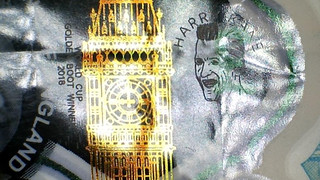 A fiver with an
engraving of footballer Harry Kane has been valued at £50,000 - but don't be tempted to create your own art on a banknote because it could cost you up to £200.
A fiver with an
engraving of footballer Harry Kane has been valued at £50,000 - but don't be tempted to create your own art on a banknote because it could cost you up to £200.
Six £5 notes with the image of the England striker have been created and released into circulation by micro-engraver Graham Short.
But budding artists be warned, unless you get the right permissions you could face a fine for defacing a banknote.
It is illegal to deface banknotes by printing, writing or adding words, letters or figures.
It is up to the police and courts whether or not to prosecute.
The same rules apply to coins; the 1971 Coinage Act says that no-one without authority can melt down or break up any metal coin.
But, it is not illegal to destroy money by tearing it or burning it.
Mr Short, who previously etched Jane Austen on new £5 notes when they were first circulated, informed the Bank of England what he was planning before he went ahead.
"With the Jane Austen notes, I contacted the Bank of England and told them what I was going to do, and straight away they said since the 1928 Bank Act, you can't deface currency," he said.
"I thought about that, and I decided that I really wanted to do it, so I called them back, and I spoke to a different person.
"They said 'we've been talking about you here.'
"[They] were encouraging me to do it and were quite relaxed about it."
To read the complete article, see:
Harry Kane fiver: Is it legal to draw on money? (https://www.bbc.com/news/uk-wales-45084934)
To read the earlier E-Sylum article, see:
IN OTHER NEWS: AUGUST 5, 2018 : Graham Short Releases Another Micro-Engraved Banknote
(http://www.coinbooks.org/v21/esylum_v21n31a46.html)
ART UNITS: COINS MADE OF GLASS
Community Currency is a recurring topic here in The E-Sylum. Here's a story Philadelphia's The Inquirer about an art group producing glass coins as an "art-based" currency. -Editor
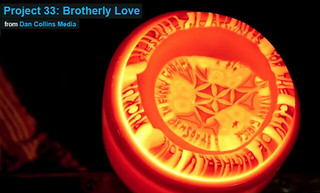 Braun's Art
Units are not the first alternative money of their kind. In economic terms, they're "community currency," a type of money often focused on a geographic region.
Examples include Ithaca Hours in Ithaca, N.Y., COjacks in Colorado, Eugene Skinners in Eugene, Ore., and BerkShares in Massachusetts. Art Units are similar but focus on glass
collectors as an interest group, specifically those based in the glass pipe movement, in which Braun made his a name over the last 20 years.
Braun's Art
Units are not the first alternative money of their kind. In economic terms, they're "community currency," a type of money often focused on a geographic region.
Examples include Ithaca Hours in Ithaca, N.Y., COjacks in Colorado, Eugene Skinners in Eugene, Ore., and BerkShares in Massachusetts. Art Units are similar but focus on glass
collectors as an interest group, specifically those based in the glass pipe movement, in which Braun made his a name over the last 20 years.
"The Art Unit is a piece of art, like the Mona Lisa downsized into little inch-by-inch coins, and it's backed up by the art itself," says Jessica Boggs, 38, Braun's significant other, mother of their child, Phoenix, and member of the crew. "It's kind of like a gold coin, but it has work and energy in it instead of a precious metal."
The Ruckus event was the first of its kind for the Starship, in which Braun and his team created an Art Unit from start to finish. The unit was later cut and polished into individual coins at a glass studio. They will be released to the public on Wednesday at Ruckus Gallery, along with an an exhibit explaining the production of the coins.
Bearing heady messages like "Art Seeds Dreams" and "An Alternative Is Possible," Art Units began in 2013 as an extension of Braun's Project 33. More a philosophy than an art project, Project 33 focuses on "mutual support," Braun said, and involves everything from growing your own food to creating an alternative economy. Art Units are among its most ambitious directives, and are created by a variety of artists on a volunteer basis.
"Each Art Unit is $10, so in terms of what it's worth, it's measured by the amount of resources and community energy and skill that goes into the creation of the coin," says local filmmaker Dan Collins, director of Project 33: An Alternative Is Possible, a free documentary on Vimeo about Braun's project that was screened at Friday's event. "Essentially, it's meant to serve as a form of barter that removes the glass community from the burden of using U.S. dollars and buying into the banking system."
About 40 Art Unit editions have been produced. Denominations range from 3.3 to 100, meaning the coins have a face value of between $33 and $1,000. Coins have been created to help various charities and individuals; others " those marked with an infinity symbol " are intended as gifts. Sales are handled primarily at A Starship in Every Garage's Instagram page.
If anyone reading this feels U.S. dollars are a burden, I'll be happy to take them off your hands and lighten your load. -Editor
To read the complete article (and watch the videos), see:
A famous glassmaker came to Philly to create his own form of
currency (http://www.philly.com/philly/entertainment/arts/glassblowing-marcel-braun-arts-units-starship-20180808.html)
IN OTHER NEWS: AUGUST 12, 2018
Here are some additional items I came across in the media this week that may be of interest. -Editor
Autonomous Vehicle Helped Locate San Jose Wreck
John Wilson forwarded this Fox News story about the robot vehicle that was used to locate the wreck of the San Jose. -Editor
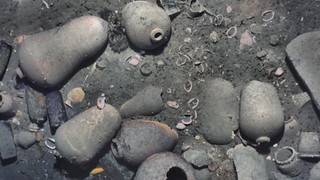 An autonomous vehicle was used in 2015
to locate a Spanish galleon that sunk 300 years ago off the coast of Colombia with $17 billion in treasure, the research team that helped in the discovery said on Monday.
An autonomous vehicle was used in 2015
to locate a Spanish galleon that sunk 300 years ago off the coast of Colombia with $17 billion in treasure, the research team that helped in the discovery said on Monday.
The San Jose, which was considered the "holy grail of shipwrecks," was located with the help of an underwater autonomous vehicle operated by the Woods Hole Oceanographic Institution.
To read the complete article, see:
Autonomous vehicle helped locate— holy grail of
shipwrecks' off Colombia (http://www.foxnews.com/science/2018/05/22/autonomous-vehicle-helped-locate-holy-grail-shipwrecks-off-colombia.html)
To read the earlier E-Sylum articles, see:
SAN JOSE GALLEON FOUND: THE HOLY GRAIL OF SHIPWRECKS (http://www.coinbooks.org/esylum_v18n49a26.html)
COLOMBIA PLANS TO SALVAGE THE SAN JOSÉ (http://www.coinbooks.org/v20/esylum_v20n28a25.html)
SPANISH GALLEON SAN JOSE FOUND (http://www.coinbooks.org/v21/esylum_v21n22a38.html)
On Anonymous Personalities
Mary Lannin writes:
This is somewhat tangential to our world, but it's interesting.
Thanks. This Artnet News article discusses a possible clue to the identity of the anonymous street artist Banksy. -Editor
Few people know Banksy's closely guarded true identity, but many have speculated that Bristol resident Robin Gunningham is the man behind the anonymous street artist's infamous moniker. Now, a print of a drawing by Gunningham is being auctioned by online art brokerage My Art Broker, and the piece is enticing speculators to wager £4,000 ($5,242) on the name, in the hope that they might get their hands on an original Banksy.
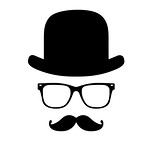 While numismatics has many
unknown or forgotten personalities, other than forgers the only intentionally anonymous parties are high-end collectors who wish to keep a low profile. Generally the numismatic
press abides by their wishes, while their true identities are often an open secret among our small community. Are there any such anonymous personalities who were never unmasked,
even after their death? -Editor
While numismatics has many
unknown or forgotten personalities, other than forgers the only intentionally anonymous parties are high-end collectors who wish to keep a low profile. Generally the numismatic
press abides by their wishes, while their true identities are often an open secret among our small community. Are there any such anonymous personalities who were never unmasked,
even after their death? -Editor
To read the complete article, see:
Is Robin Gunningham Banksy? This Early Album Cover Art Might Be the Best Clue Yet"and Now It's Up
for Sale (https://news.artnet.com/art-world/early-banksy-auction-1329194)
PERTH MINT WORKER STOLE $40K IN GOLD
There's always a new angle for stealing from the Mint. This Kitco story from Australia is about a computer technician caught smuggling out gold. -Editor
 An IT technician working for the
Australian Perth Mint stole AUD$55,000 (USD$41,000) worth of gold coins and bars "to maintain a lifestyle" demanded by his then-fiancé, " according to the defense
lawyer on the case.
An IT technician working for the
Australian Perth Mint stole AUD$55,000 (USD$41,000) worth of gold coins and bars "to maintain a lifestyle" demanded by his then-fiancé, " according to the defense
lawyer on the case.
Following court proceedings, the judge sentenced Joseph Charles Viola to two years in prison, requiring him to serve at least half the term before being eligible for early release.
Five gold bars and eight gold coins, including a limited edition Kimberley sunrise coin, were first discovered missing in an audit conducted by the Mint's security team, ABC News reported.
Once investigation began, the reviewed CCTV footage revealed Viola taking one of the gold coins from a vault, placing it in a computer tower, then transferring it into his trousers and leaving the Mint's premises.
It was also later discovered that Viola sold a number of Mint's coins and gold bars to a gold bullion dealer located just across the road. He made more than USD$40,000 from the transactions.
The state prosecutor Sarah Keogh said that Viola used his IT position to convince the Mint to change its security protocols, including not x-raying the computer hard drives by falsely claiming that this could have damaged the contents of the stored items.
To read the complete article, see:
News Bites Perth Mint's IT Guy Steals $40K Worth
Of Gold To 'Shower' Fiancée 'With Gifts' (http://www.kitco.com/news/2018-08-05/Perth-Mint-s-IT-Guy-Steals-40K-Worth-Of-Gold-To-Shower-Fianc-e-With-Gifts.html)

